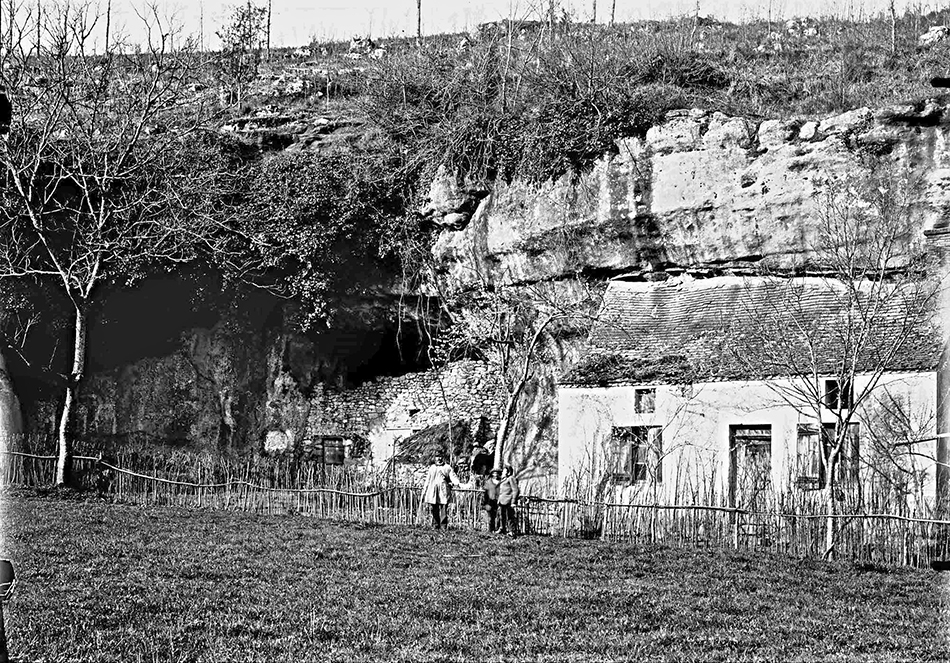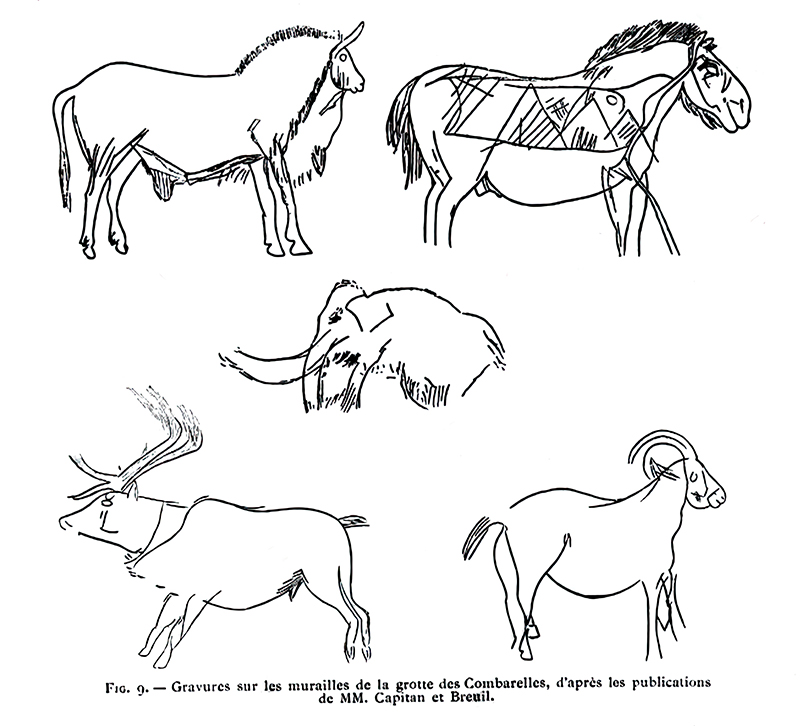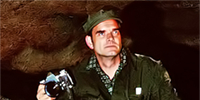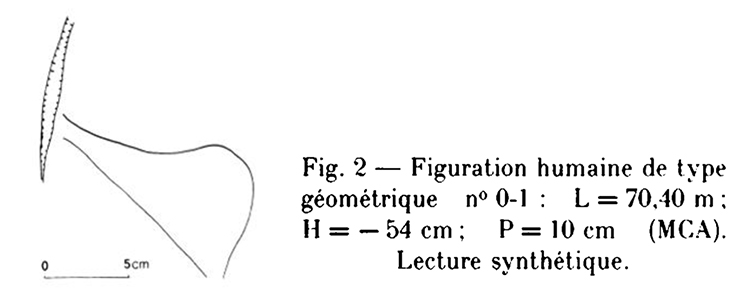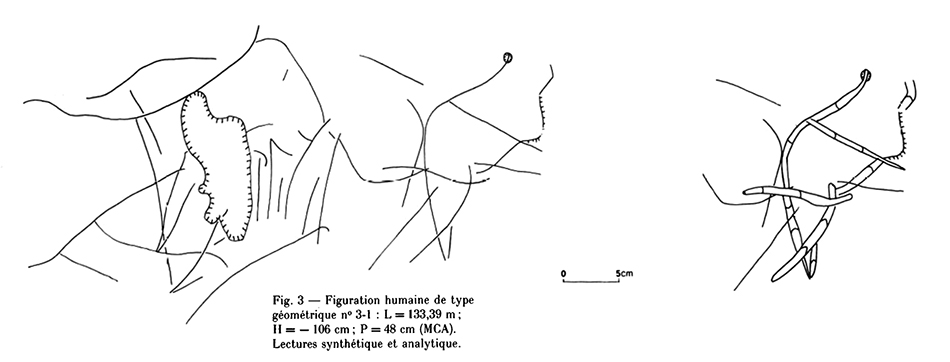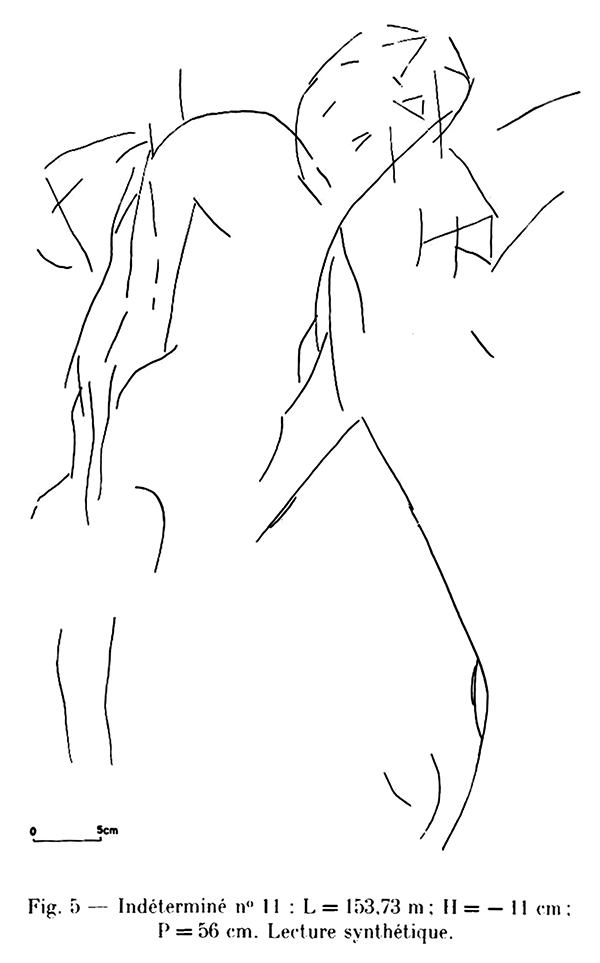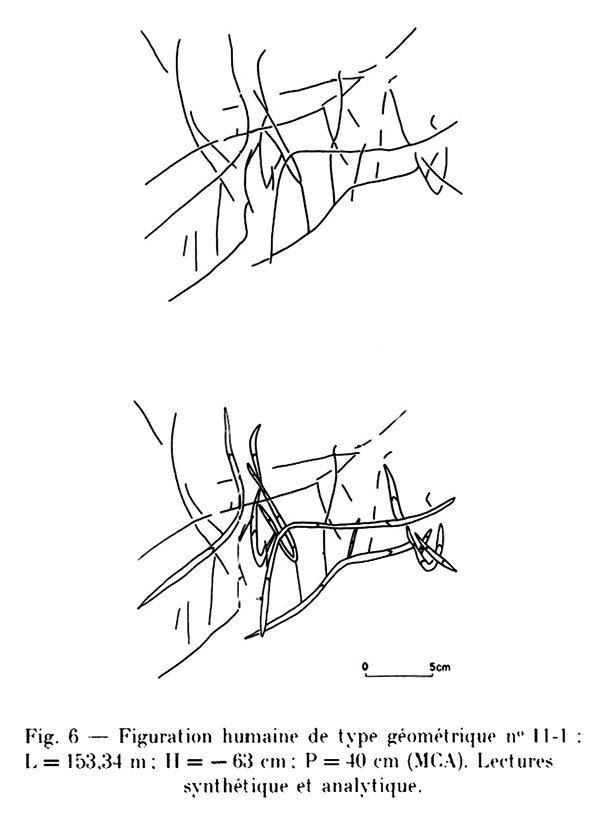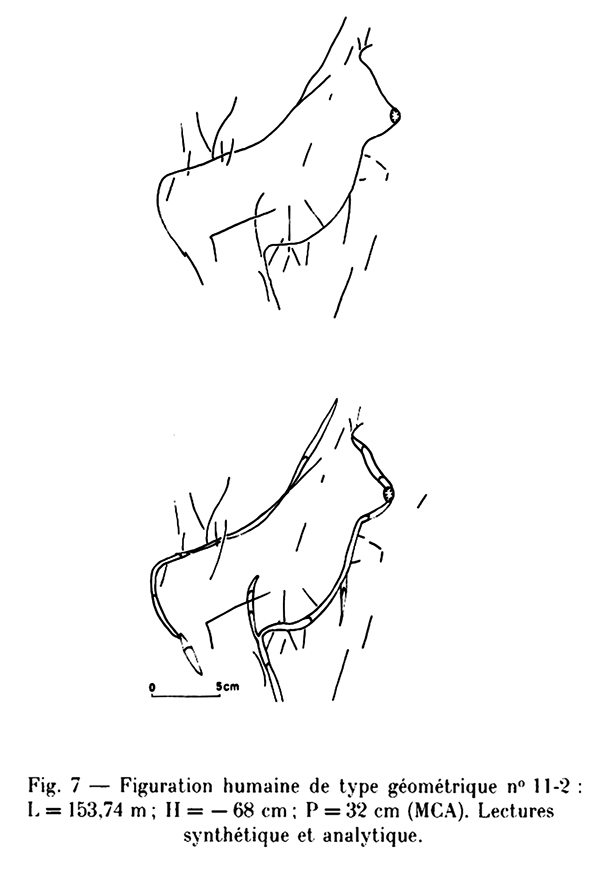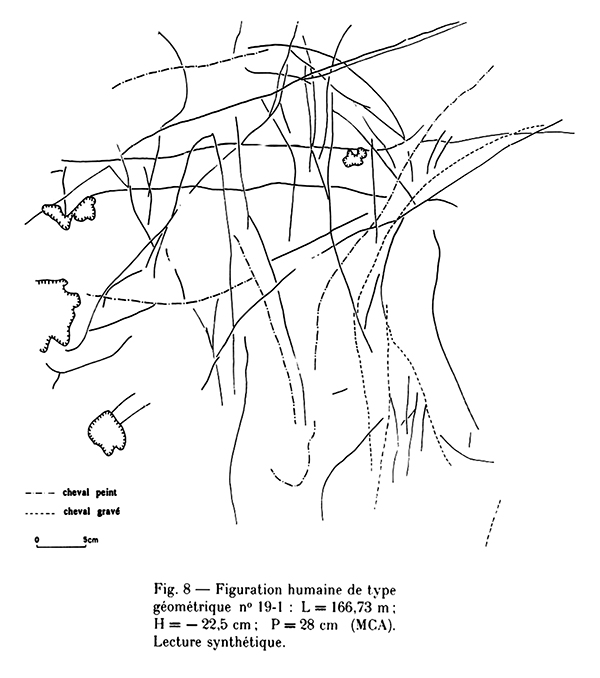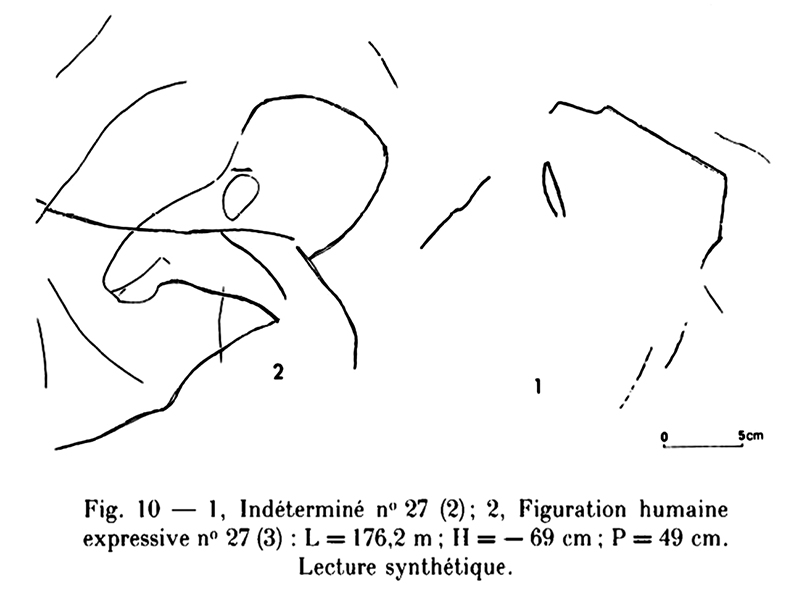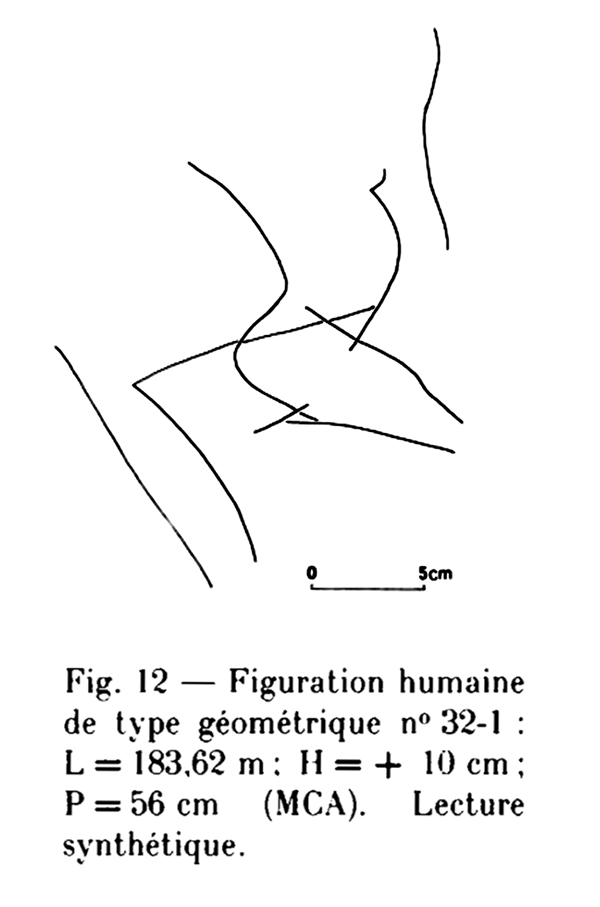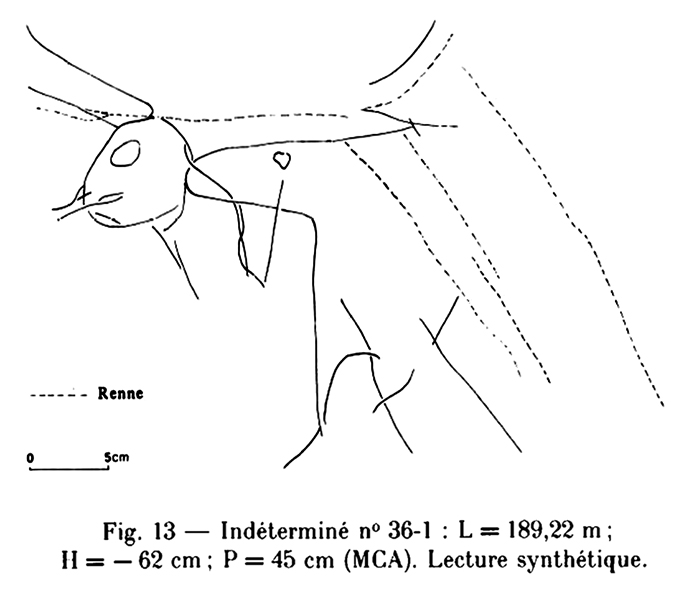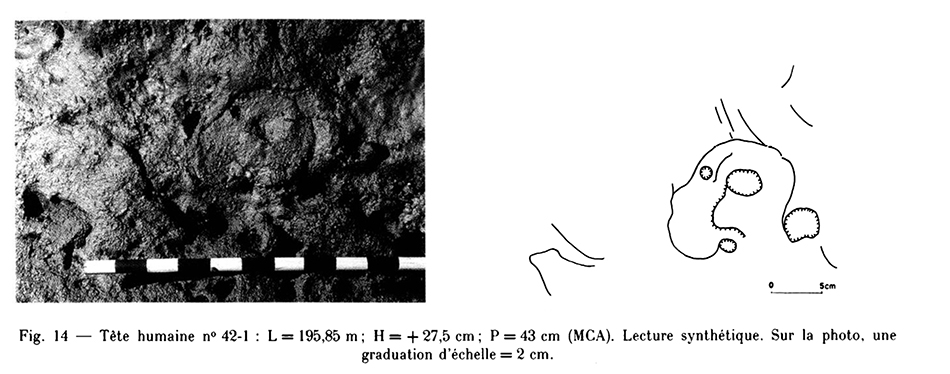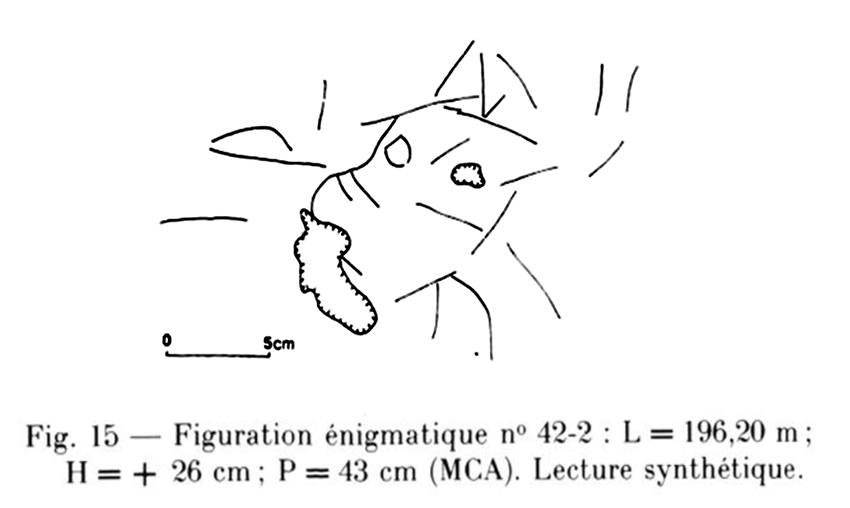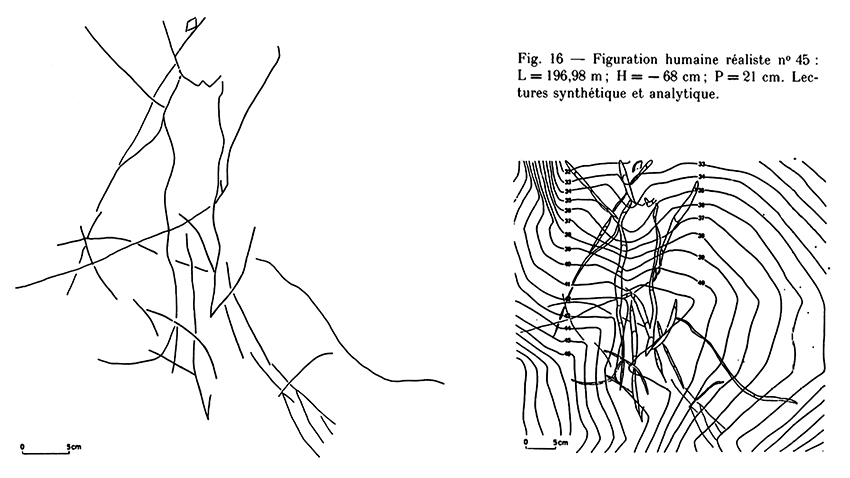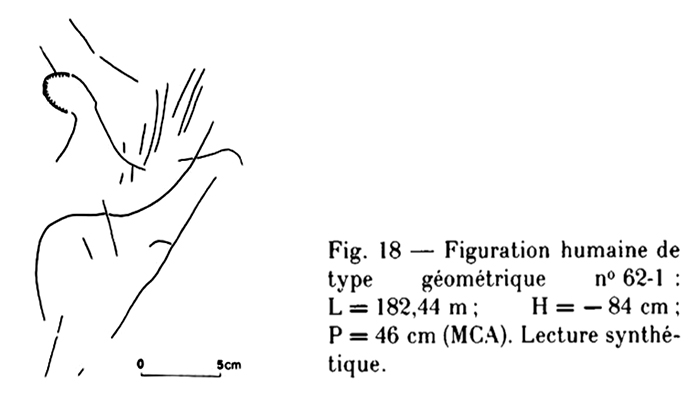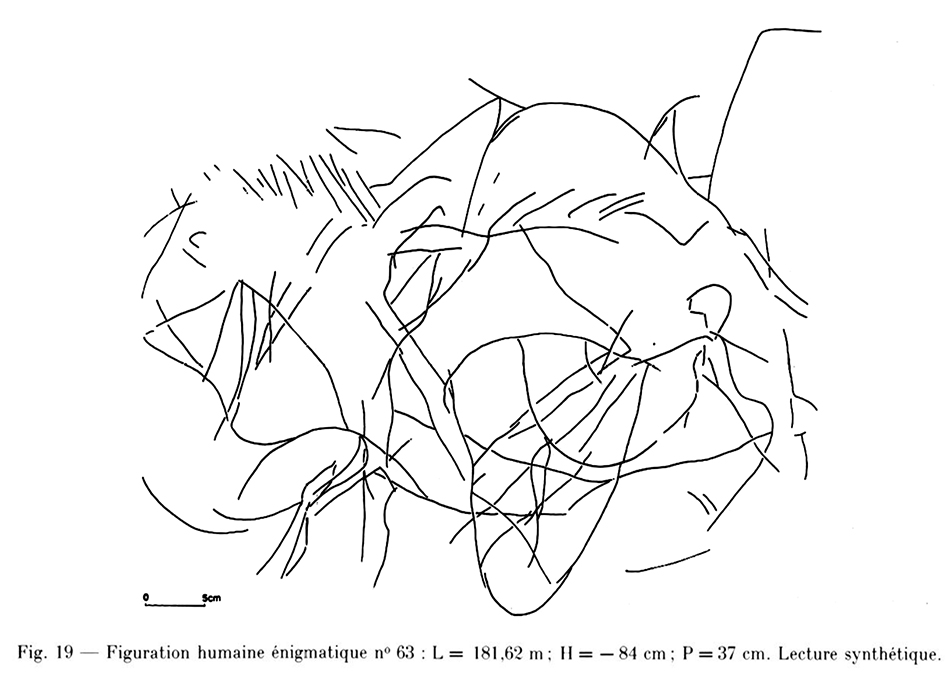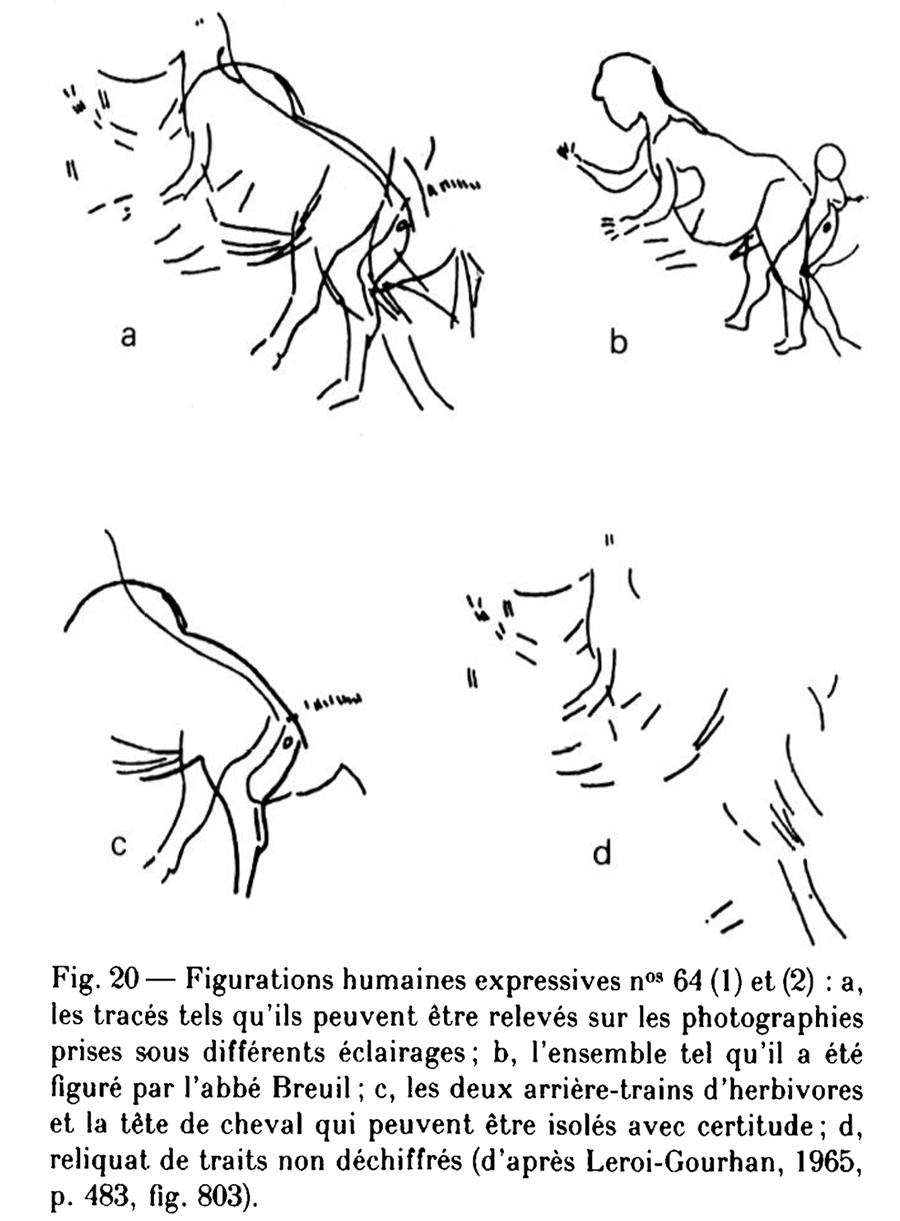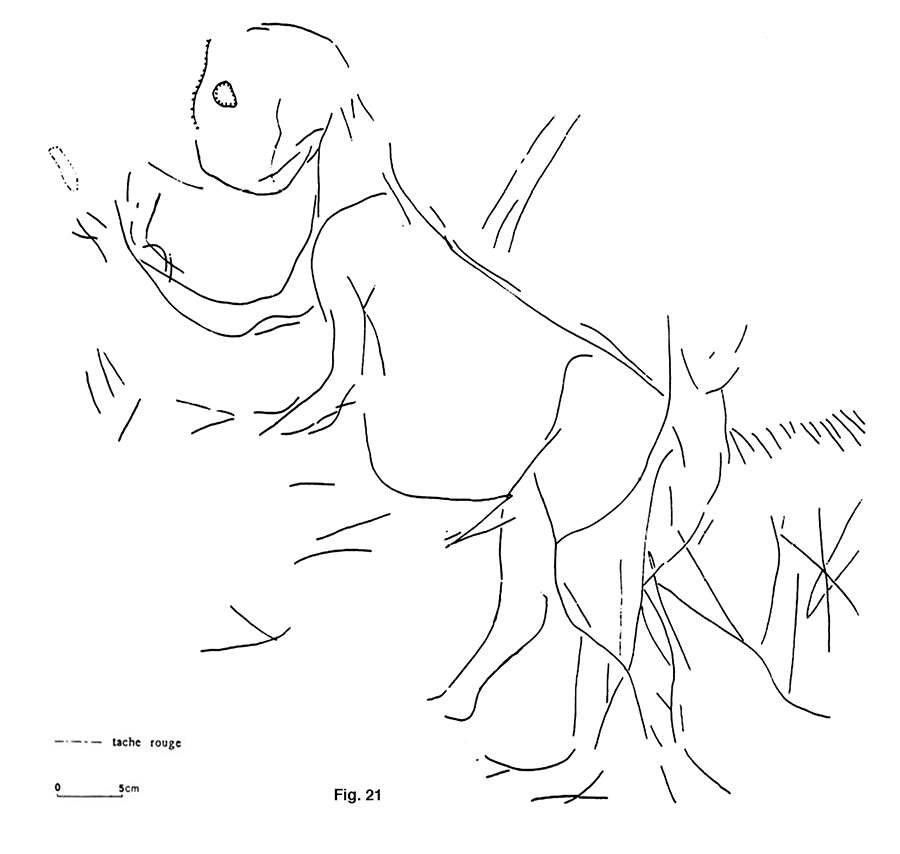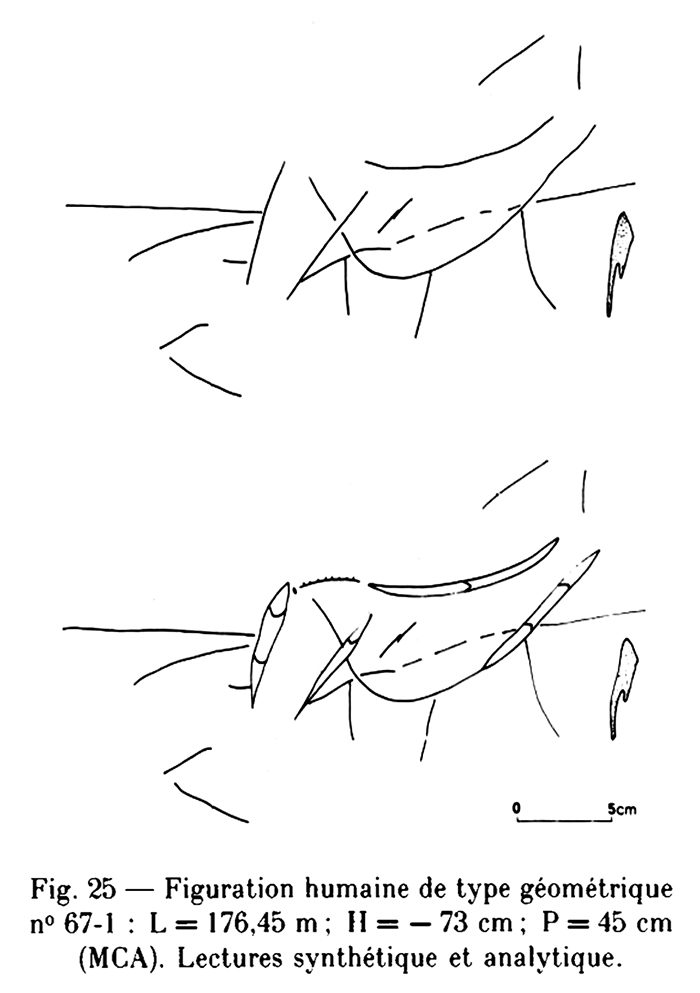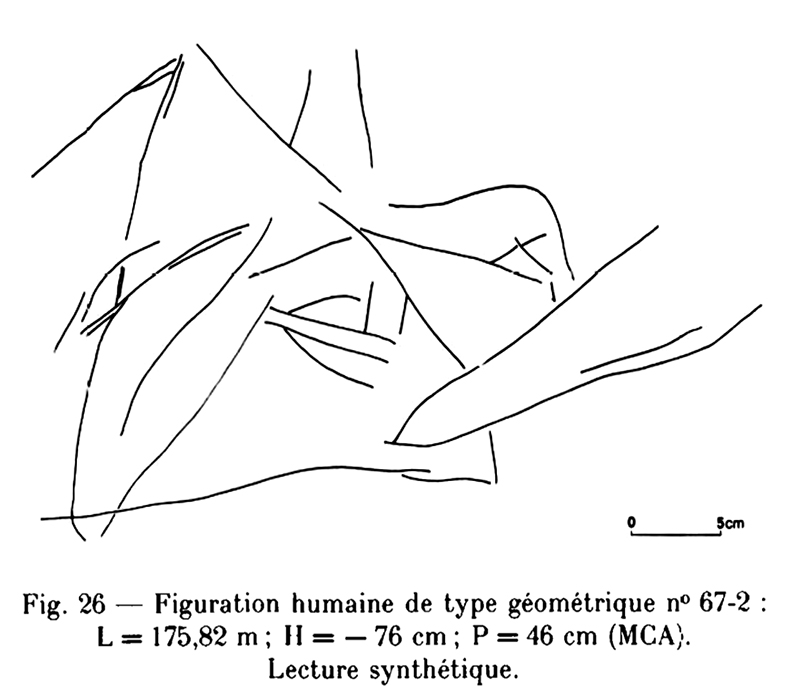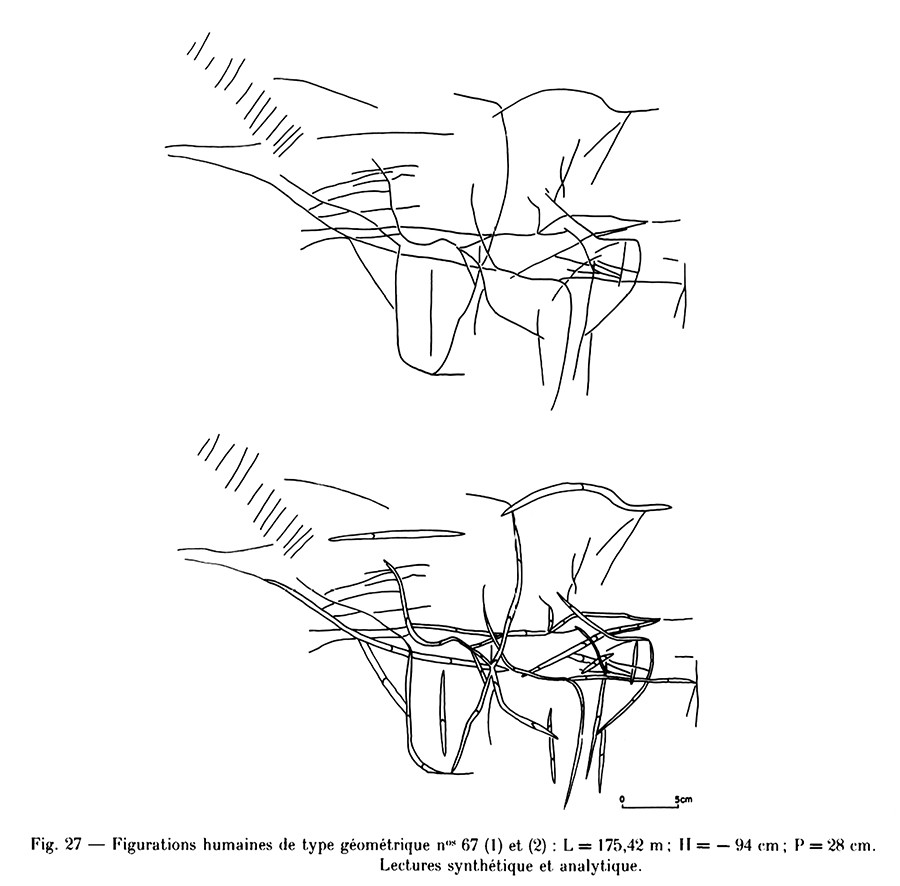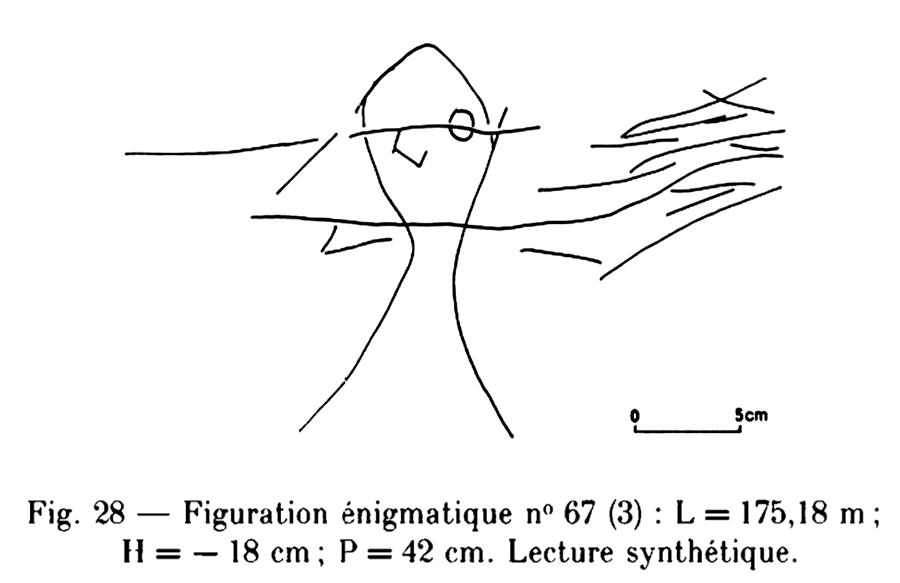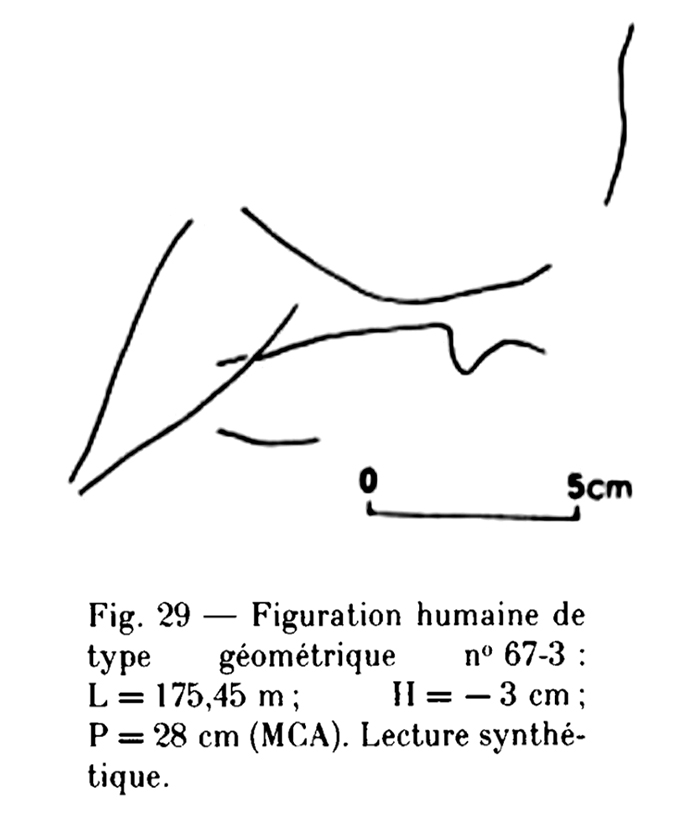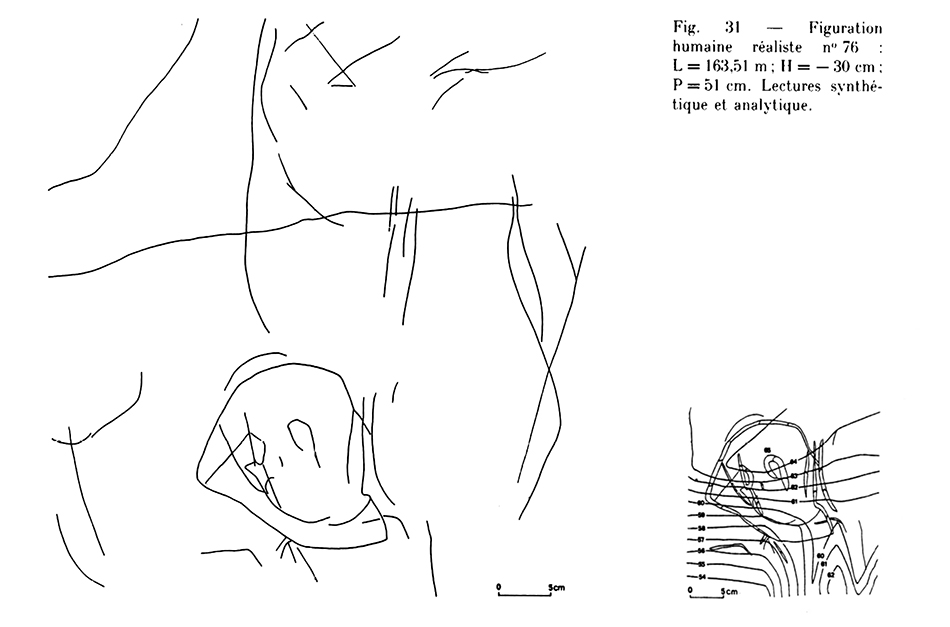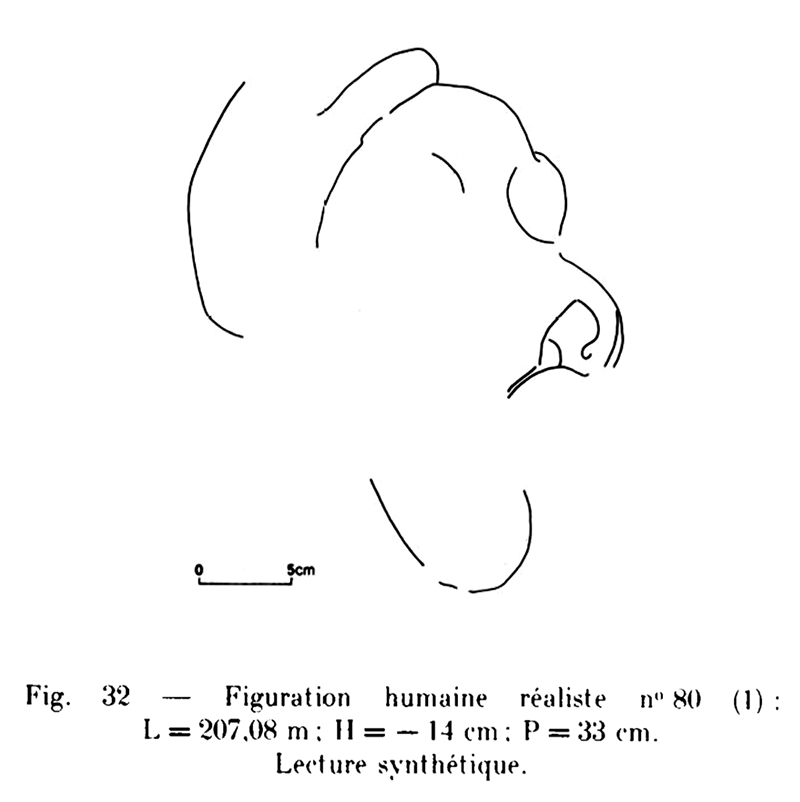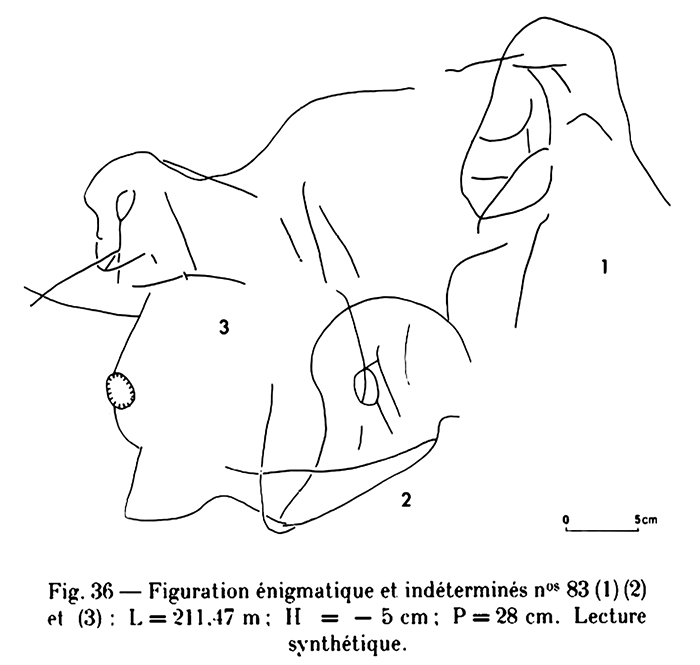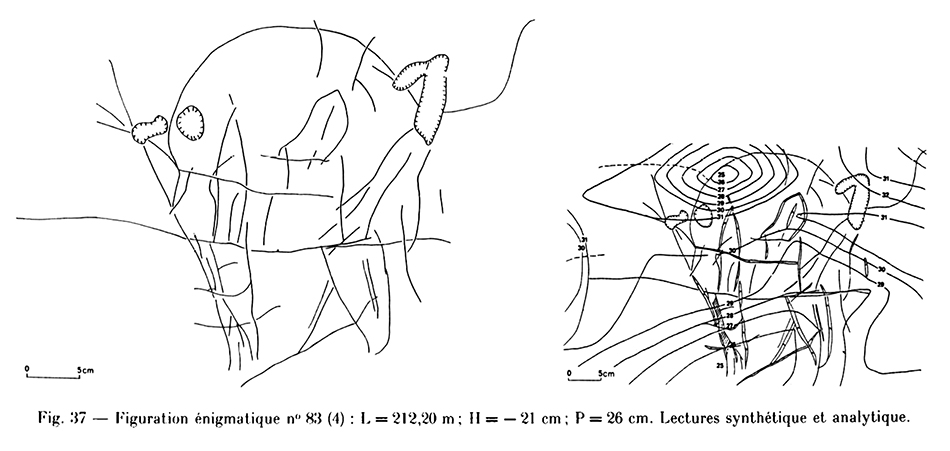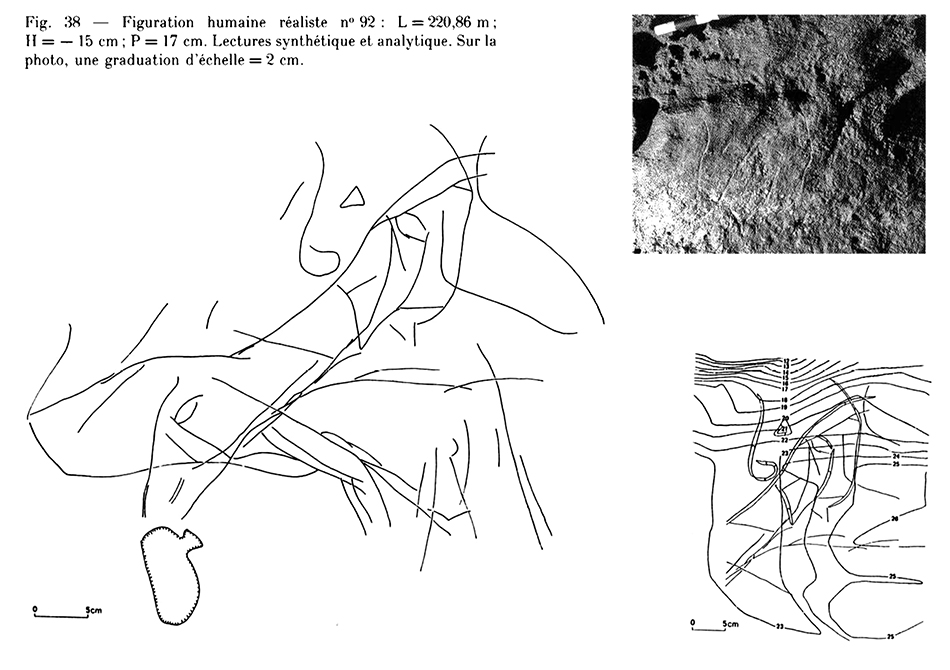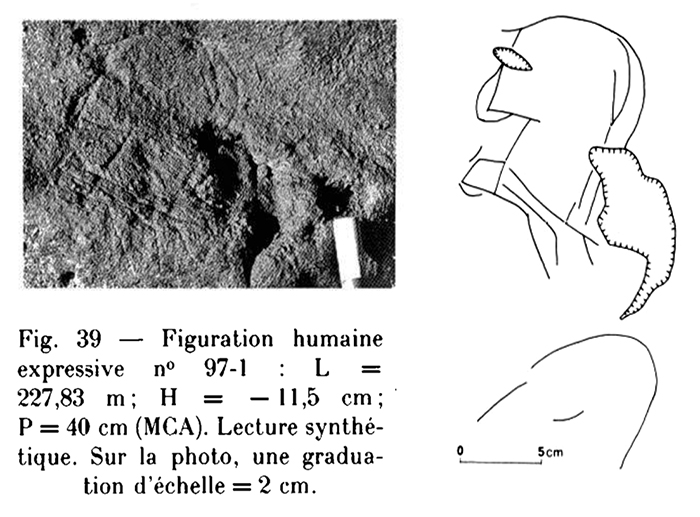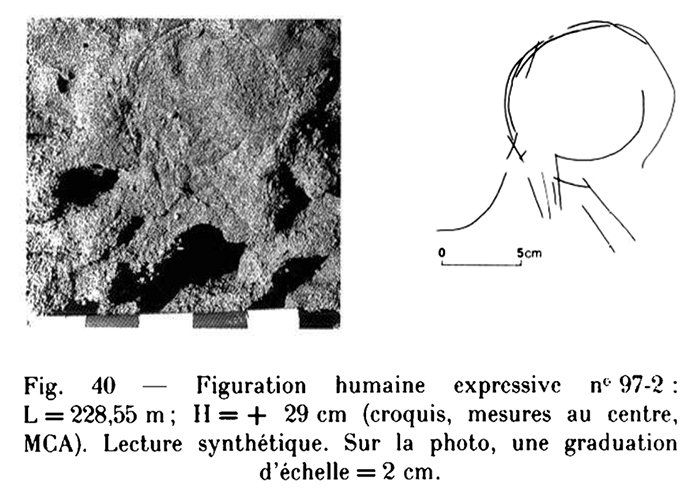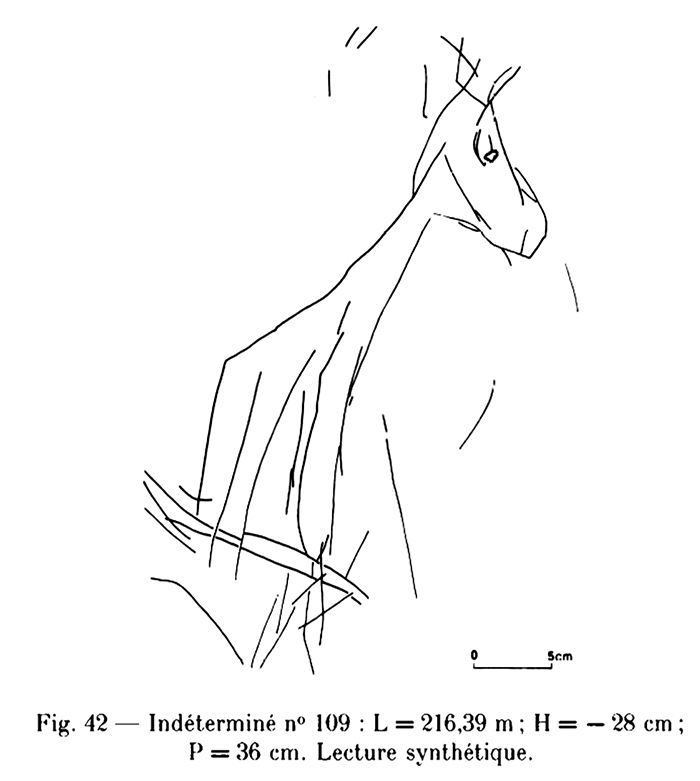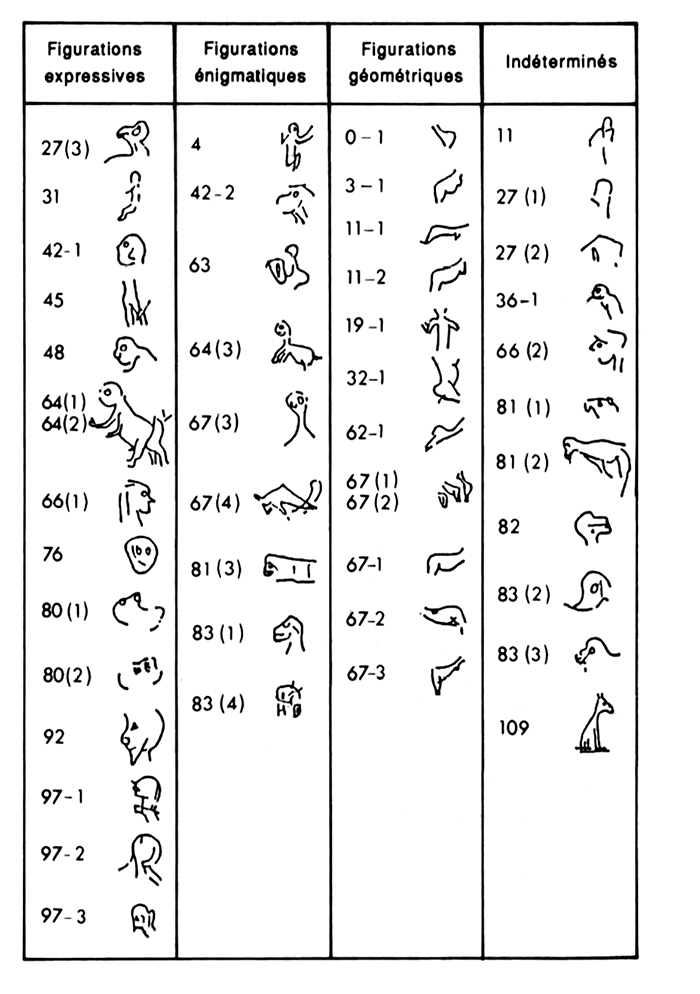Back to Don's Maps
 Back to Archaeological Sites
Back to Archaeological Sites
Les Combarelles in the Dordogne

The little valley of Les Combarelles cave
Photo: Sémhur (2009a)
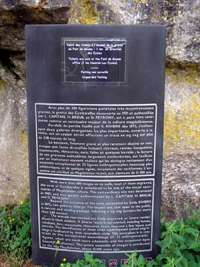
With more than 600 images on its walls, most of them engraved, the cave of Combarelles is considered to be one of the major sanctuaries of Magdalenian culture. This extraordinary site was discovered in 1901, and was quickly authenticated by L. Capitan, H. Breuil and D. Peyrony.
Beyond the entrance of the cave, excavated by Emile Riviere in 1892, two galleries diverge. The largest one, now open to the public, is a narrow and winding passage, following a zig zag pattern for more than 240 metres.
The animals represented are finely engraved, or (more rarely) drawn in black outlines. A diverse fauna is represented, including horses, reindeer, ibex, mammoths, rhinoceros, bears, lions and a few bisons and aurochs. The identification of these often superimposed animal engravings is facilitated by their naturalistic style. This naturalism is in contrast to the exceptional assemblage of 52 anthropomorphic figures, which are more schematic, and the occasional signs (mostly tectiforms). The entire ensemble of images is attributed to the late Magdalenian, about 13 000 years ago.
Text: Sign outside Les Combarelles
Photo: Don Hitchcock 2008
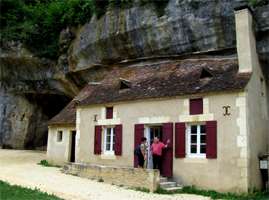
In front of the caves is an old plastered stone farmhouse, nestled under the rock overhang. It is by no means the first such dwelling, as can be seen by the lead sheet let into the cliff above it formerly providing weather protection to the roof, from water run off down the cliff, of a larger structure.
The farmhouse now provides shelter for tour guides, and a display area.
Source: Display in the Les Combarelles reception area.
Photo: Don Hitchcock 2008
The Combarelles Valley.
Photo: D. Peyrony, circa 1924, during his work on Les Combarelles with Capitan and Breuil.
Source: journals.openedition.org/paleo/4058?lang=fr
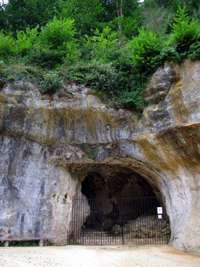
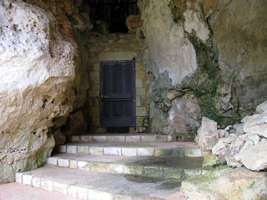
(Left) Entrance to the galleries of Les Combarelles, with Les Combarelles I on the left, and Les Combarelles II on the right.
(Right) Locked steel door giving access to tours of the engraved galleries of Les Combarelles I. Les Combarelles II is not open to the public.
Photo: Don Hitchcock 2008
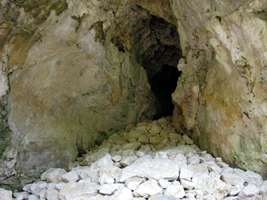
Entrance to Les Combarelles II, not open to the public.
Photo: Don Hitchcock 2008
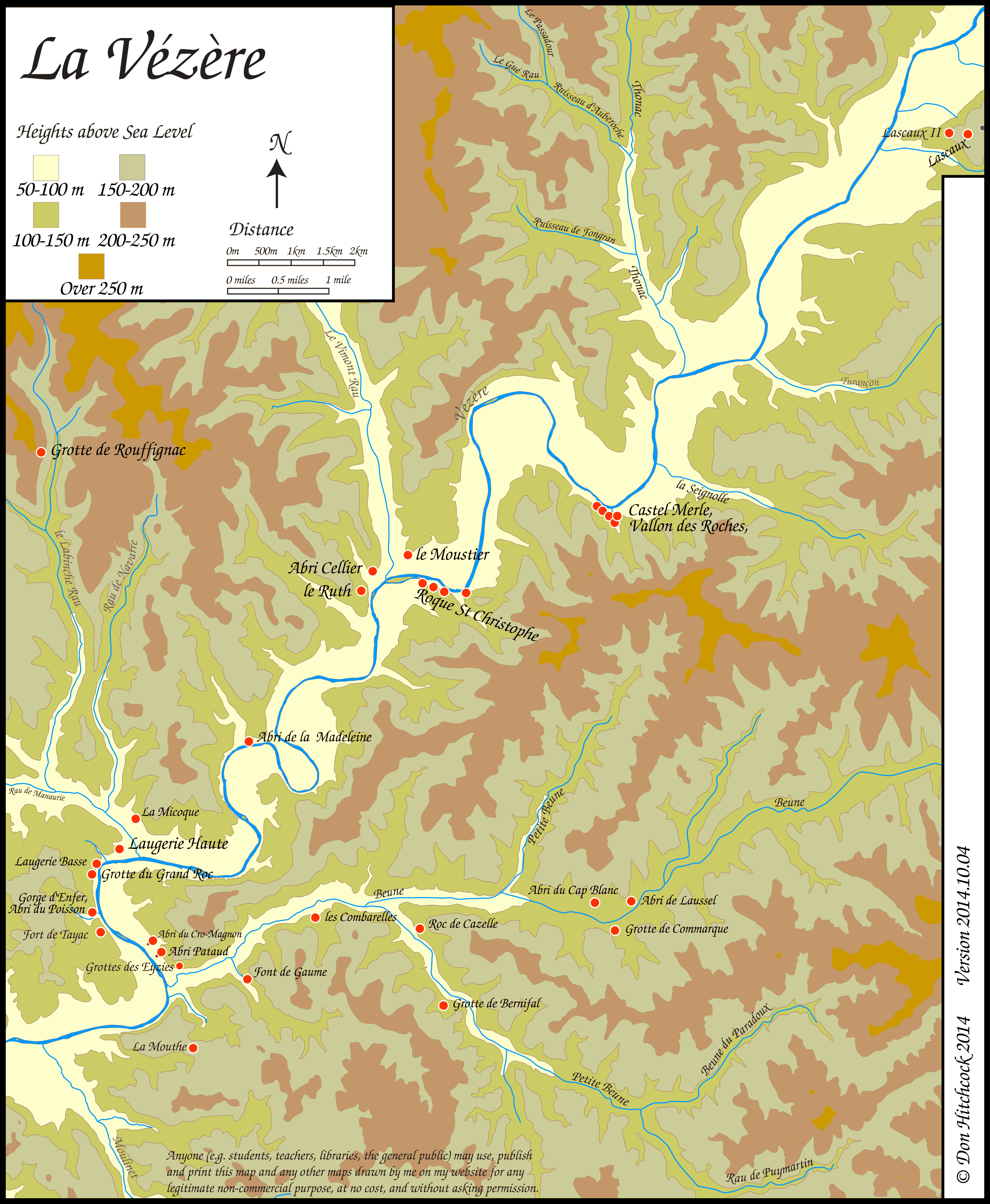
Map of sites in the Vézère Valley of France, including les Combarelles.
If you click on the map you will see a larger map with the ability to click on the marked sites and get further information.
Photo: Don Hitchcock

Plan of Les Combarelles.
Photo: Bosinski et al. (2001)
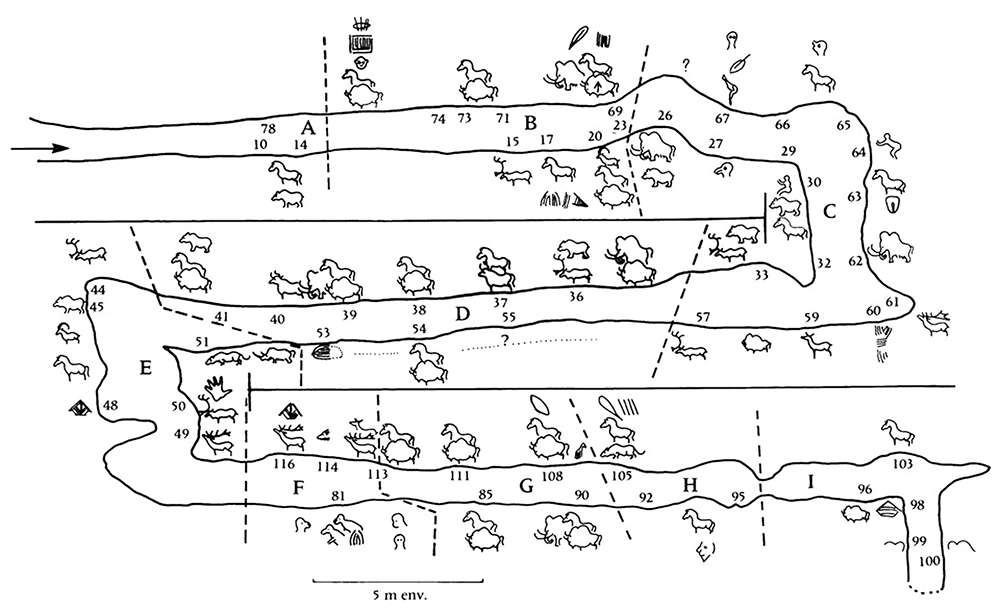
The plan of the images shown in their position in the cave. Note that not all the images are depicted in this schematic view.
Source: Capitan et al. (1924)
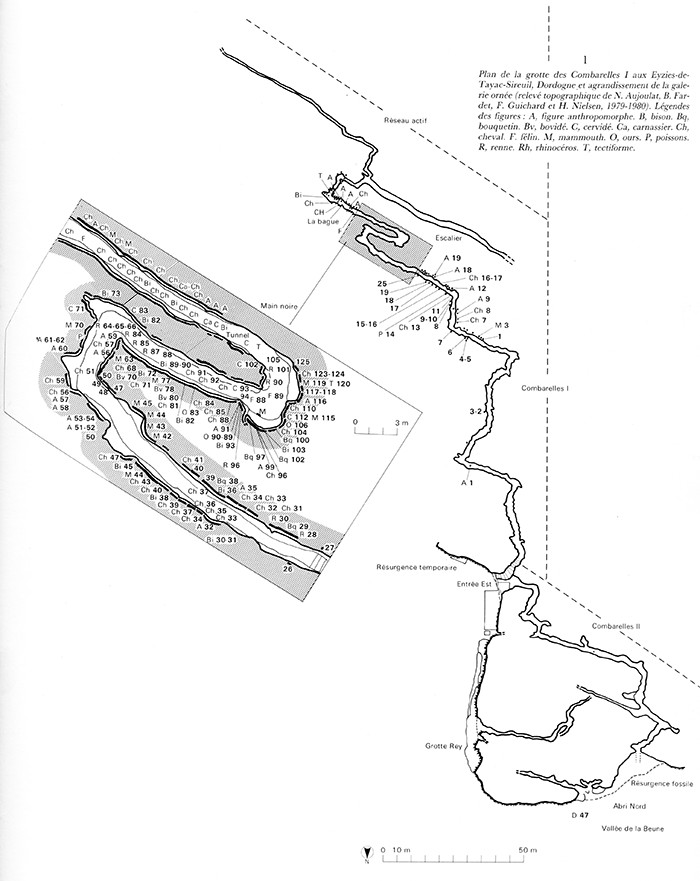
Plan of Les Combarelles I.
This plan uses the numbering of H. Breuil.
Photo: C. Barrière
Source: Leroi-Gourhan (1984)
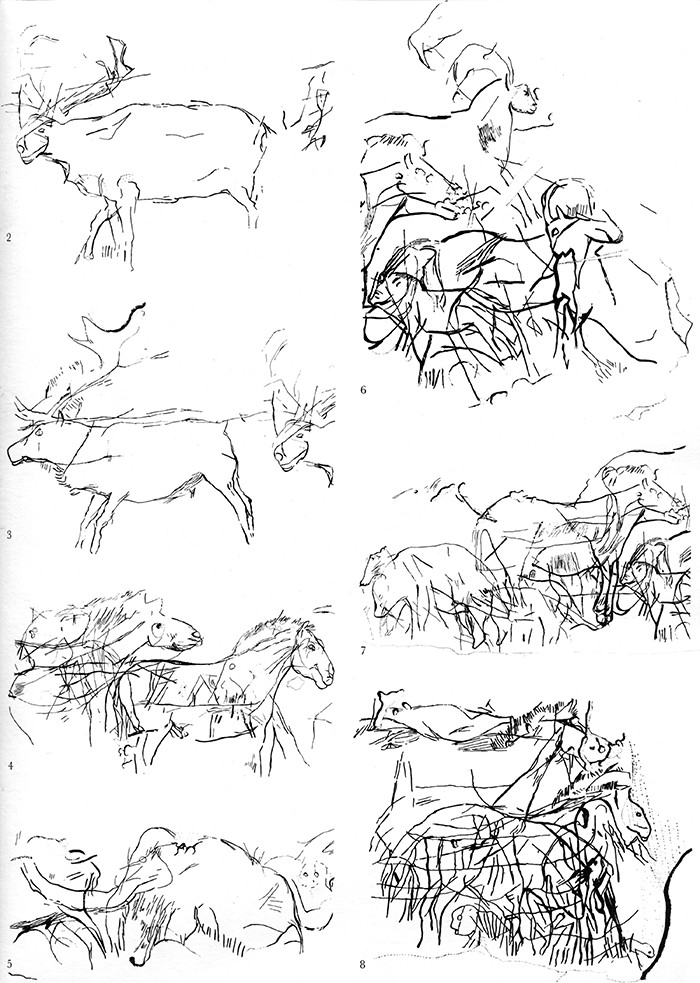
Drawings of selected engravings from Les Combarelles I.
The numbers used for these drawings correspond to a different numbering system being developed by C. Barrière
2 Right wall: reindeer following each other (no. 28)
3 Right wall: reindeer following each other (no. 30)
4 Right wall: horses (no. 32 to 35)
5 Right wall: mammoth (no. 63)
6 Right wall: ibex and horses (no. 98 to 103)
7 Right wall: horse and bears (no. 101 to 106)
8 Right wall: horses and bears, doe, anthropomorphic figure (no. 110 to 116)
Photo: C. Barrière
Source: Leroi-Gourhan (1984)
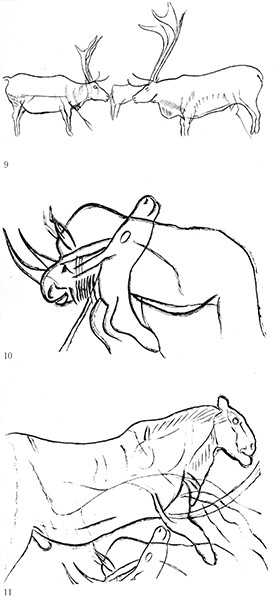
Drawings of selected engravings from Les Combarelles I.
9 Two reindeer facing each other
10 Rhinoceros
11 Lioness
Photo: H. Breuil
Source: Leroi-Gourhan (1984)
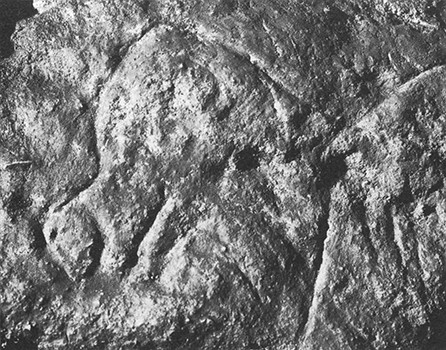
Engravings from Les Combarelles I.
12 anthropomorphic figure
Photo: N. Aujoulat
Source: Leroi-Gourhan (1984)
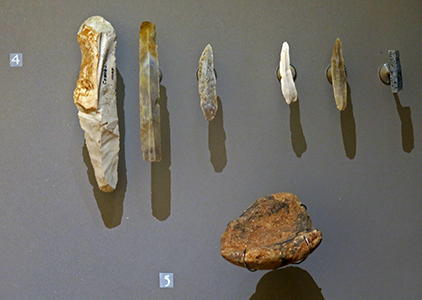
Upper Magdalenian lithic industry from the entry porch of les Combarelles, from the excavations by M. Archambeau:
Grattoir on a blade, unaltered small blades, a blade retouched on one side, and a godet - a small mortar used for grinding ochre.
Age: circa 12 000 - 10 000 BP
Photo: Don Hitchcock 2014
Source: Originals, le Musée National de Préhistoire, Les Eyzies-de-Tayac

Tools from Les Combarelles - scrapers, burins, awls, and blades of various types.
Photo: Don Hitchcock 2015
Source: Originals, Musée d'Aquitaine à Bordeaux
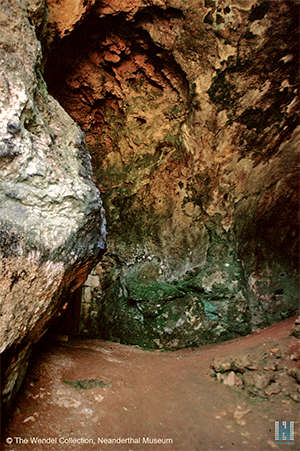
Entry to Les Combarelles.
Photo: Heinrich Wendel (© The Wendel Collection, Neanderthal Museum)

The front of a feline, facing right. It may well be that the back of the animal never existed. This fine engraving shows a round nostril and a well marked mouth. The eye is indicated by a small flat stone. The area has been calcified, and this may well have helped preserve the image.
Photo: Heinrich Wendel (© The Wendel Collection, Neanderthal Museum)
Text: http://www.culture.gouv.fr/culture/conservation/fr/grottes/Pageshtm/CombarellesI.htm
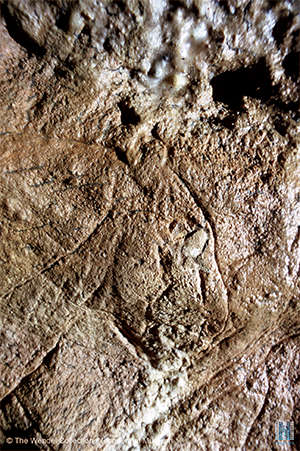
Close up of the feline head. The wall appears to have had subsequent calcification.
Photo: Heinrich Wendel (© The Wendel Collection, Neanderthal Museum)
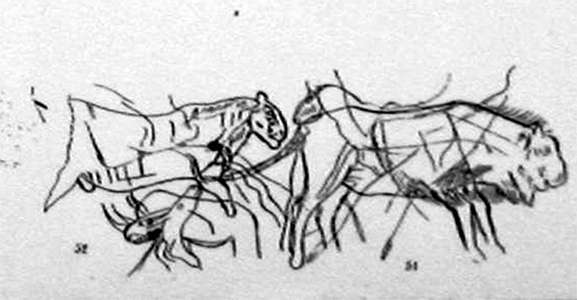
The feline above is labelled as number 52 in the 12 metre long series of drawings by Capitan and Breuil (1902a) (see the rest of these images below).
Source: Display in Les Combarelles reception area
Photo: Don Hitchcock 2008
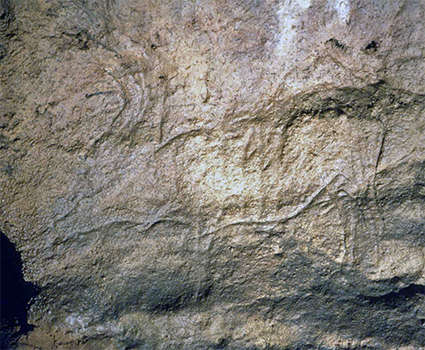
This is an engraving known as 'reindeer drinking', and is one of the best known of the cave. The animal is complete; the back is well marked, the rump is rounded, and the hind legs are marked. The antlers are huge, with wide, fingered webs, bent at right angles to the front.
Photo and text: http://www.culture.gouv.fr/culture/conservation/fr/grottes/Pageshtm/CombarelleRenneBuvant.htm

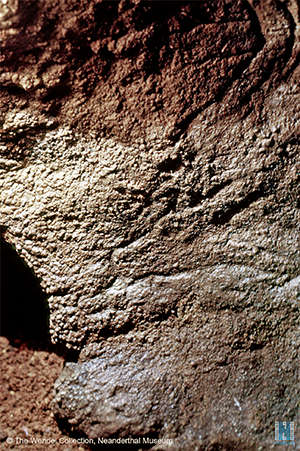
Another version of the reindeer drinking, and a closeup of the head.
Photo: Heinrich Wendel (© The Wendel Collection, Neanderthal Museum)
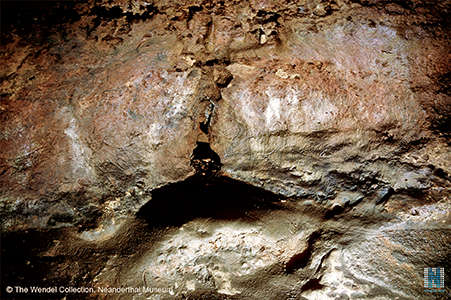
The engraving of the drinking reindeer on the right, and another which may be of a rhinoceros on the left.
Photo: Heinrich Wendel (© The Wendel Collection, Neanderthal Museum)
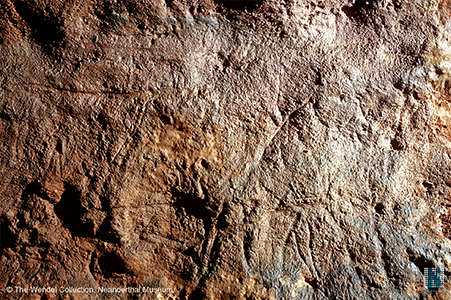
Engraving of a horse, the best represented animal in the engravings.
Photo: Heinrich Wendel (© The Wendel Collection, Neanderthal Museum)

This horse head is beautifully proportioned, by an artist with talent and a lifetime spent studying horses.
Photo: Heinrich Wendel (© The Wendel Collection, Neanderthal Museum)
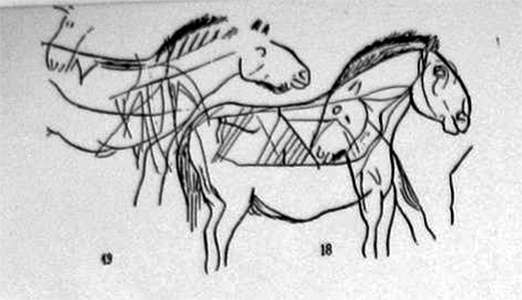
The horse head above is part of the complete horse labelled as number 18 in the 12 metre long series of drawings by Capitan and Breuil (1902a) (see the rest of these images below).
Source: Display in Les Combarelles reception area
Photo: Don Hitchcock 2008
Engravings on the walls of la grotte des Combarelles, after the publications of MM Capitan and Breuil.
Photo and text: Cartailhac et Breuil (1906)
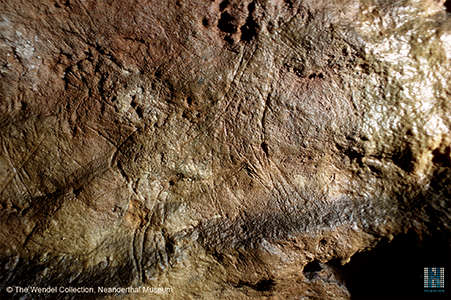
Deer with a long neck.
Photo: Heinrich Wendel (© The Wendel Collection, Neanderthal Museum)

The above deer is labelled as number 113/114 in the 12 metre long series of drawings by Capitan and Breuil (1902a) (see the rest of these images below).
Source: Display in Les Combarelles reception area
Photo: Don Hitchcock 2008

The overwhelming impression when in Les Combarelles is how narrow the passages are.
In this photograph we can see the cables on the roof of the cave that are used to supply power for the lights.
Photo: Heinrich Wendel (© The Wendel Collection, Neanderthal Museum)

Horse running with a fluid movement, beautifully realised by the artist with just a few lines.
Photo: Heinrich Wendel (© The Wendel Collection, Neanderthal Museum)
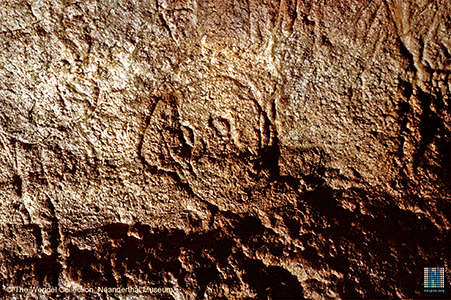
This appears to be a cartoon of a human face.
Photo: Heinrich Wendel (© The Wendel Collection, Neanderthal Museum)
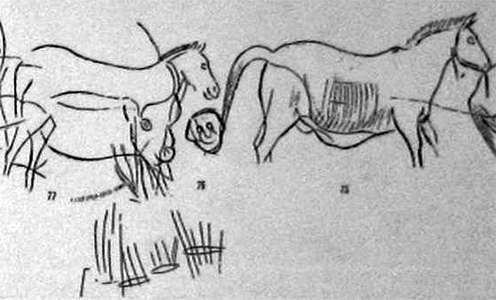
The face above is labelled as number 76 in the 12 metre long series of drawings by Capitan and Breuil (1902a) (see the rest of these images below).
Source: Display in Les Combarelles reception area
Photo: Don Hitchcock 2008

Many of the images in Les Combarelles are enigmatic, but I believe I can see on the right the dorsal and ventral line of a horse or a stag, as well as its front legs.
Photo: Heinrich Wendel (© The Wendel Collection, Neanderthal Museum)
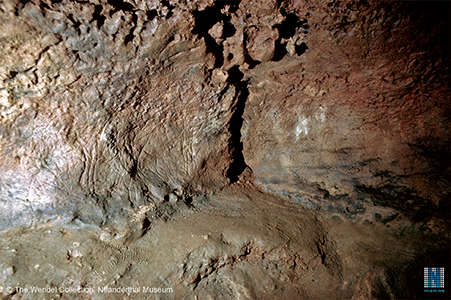
The above image in context.
Photo: Heinrich Wendel (© The Wendel Collection, Neanderthal Museum)

A close up of the right hand side of the image.
When seen in isolation like this, the engraving could almost be the outline of a human figure.
Photo: Heinrich Wendel (© The Wendel Collection, Neanderthal Museum)
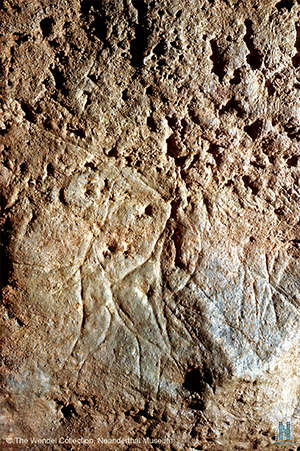
This appears to be the hindquarters of a bison.
The engraving appears almost moulded into a bas relief in this photograph.
Photo: Heinrich Wendel (© The Wendel Collection, Neanderthal Museum)

This appears to be an engraving of a deer, yet the tail is more like a horse.
Photo: Heinrich Wendel (© The Wendel Collection, Neanderthal Museum)

Mammoth.
Photo: Heinrich Wendel (© The Wendel Collection, Neanderthal Museum)
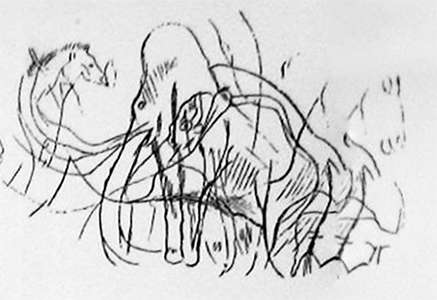
The mammoth above is number 69 in the drawings by Capitan and Breuil (1902a).
Photo: Capitan and Breuil (1902a).
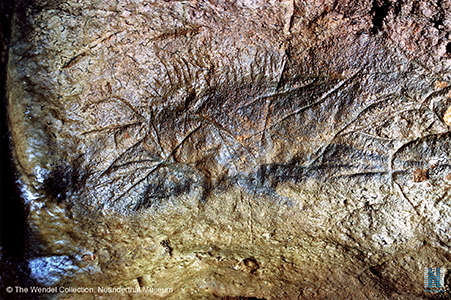
I cannot recognise an animal in this image.
Photo: Heinrich Wendel (© The Wendel Collection, Neanderthal Museum)

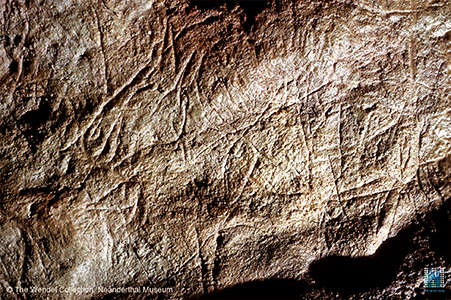
Horse, facing downwards to the left.
Photo: Heinrich Wendel (© The Wendel Collection, Neanderthal Museum)

This is the outline of a cave bear, facing to the left, with head down.
Photo: Heinrich Wendel (© The Wendel Collection, Neanderthal Museum)
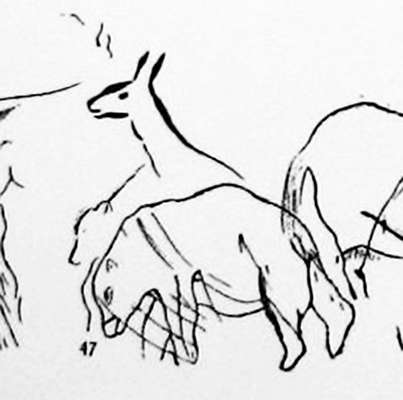
The image is labelled number 47 in the drawings by Capitan and Breuil (1902a)
Photo: Capitan and Breuil (1902a)
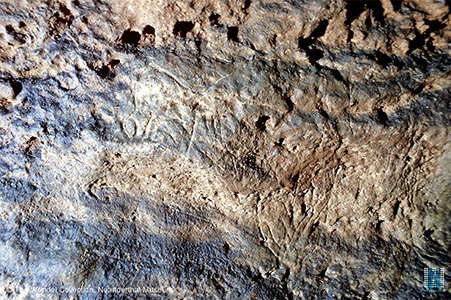
There is the head of an unidentifiable animal at centre left in this image.
Photo: Heinrich Wendel (© The Wendel Collection, Neanderthal Museum)
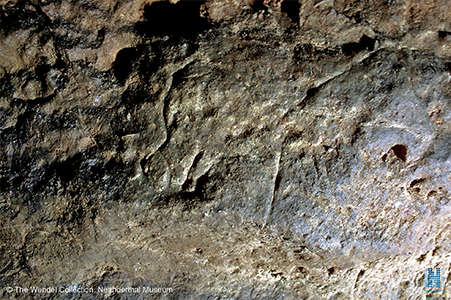
I cannot recognise an animal in this image.
Photo: Heinrich Wendel (© The Wendel Collection, Neanderthal Museum)
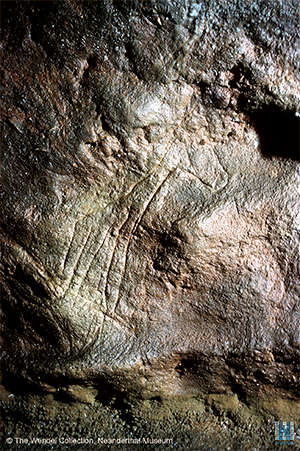
Horse head and front legs.
Photo: Heinrich Wendel (© The Wendel Collection, Neanderthal Museum)
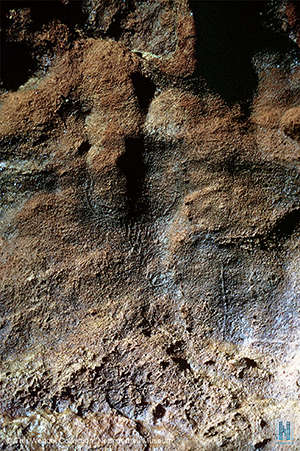
Aurochs head facing to the front.
Photo: Heinrich Wendel (© The Wendel Collection, Neanderthal Museum)

Deer head. The head is quite bulbous or cartoon-like.
Photo: Heinrich Wendel (© The Wendel Collection, Neanderthal Museum)
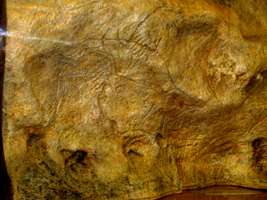
Facsimile of part of the engraved walls.
Source: Display in the Les Combarelles reception area.
Photo: Don Hitchcock 2008
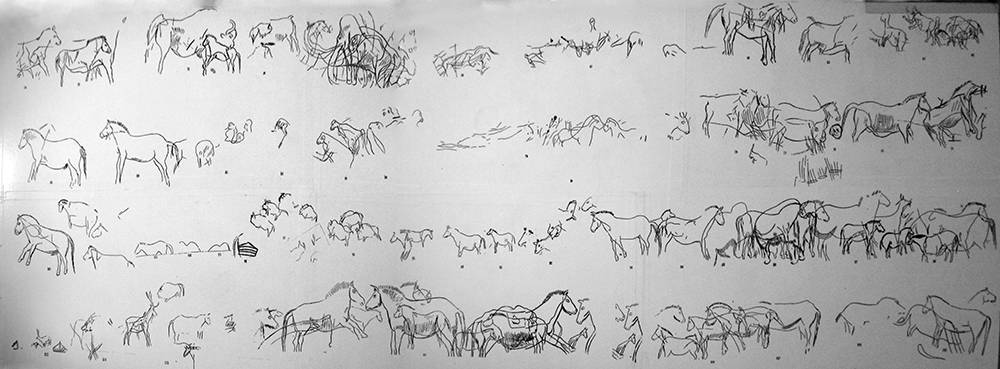
A display of some of the engravings in the cave system. These are sections of the 12 metre long 'ribbon' of drawings created by Capitan and Breuil (1902a)
Source: Display in the Les Combarelles reception area.
Photo: Don Hitchcock 2008

A display of some of the engravings in the cave system. These are sections of the 12 metre long 'ribbon' of drawings created by Capitan and Breuil (1902a)
Source: Display in the Les Combarelles reception area.
Photo: Don Hitchcock 2008

Monograph by Capitan, Breuil and Peyrony on Les Combarelles published in 1924 - by the serial number, the first such copy!
Photo: Don Hitchcock 2008
Sculptures of animals from the time of the artists of Les Combarelles
These finely made sculptures were in display cases in the reception area of Les Combarelles. I assume they were for sale, and I was impressed with their good proportions and detail. The artist is unknown.
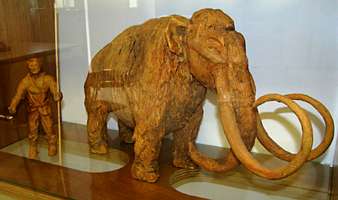
The sculpture of the mammoth is especially valuable because of the inclusion of a human figure at the same scale. Mammoths were the largest animals of the time in the area. They were smaller than an African elephant, about the same size as an Asian elephant, standing 3 metres high at the shoulder. Nevertheless they would have been a formidable prey to bring down. The meat and fat they carried, as well as their huge and thick hide would have made them very valuable to the people of the time. Bones and ivory could have been scavenged from mammoths which died a natural death.
Photo: Don Hitchcock 2008
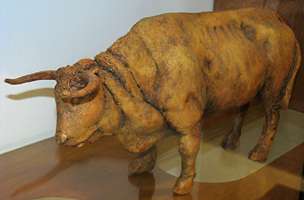
This Aurochs was particularly well fashioned. The Aurochs is the ancestor of modern cattle. Like most of the animals on display here, and depicted on the walls of Les Combarelles, it was a creature of the well grassed open plains and wide valleys, such as the Dordogne region in ice age times.
Photo: Don Hitchcock 2008
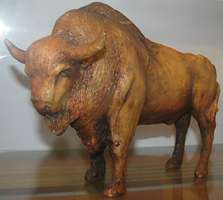
The European Bison, like the Aurochs, were most often in herds, and the hunters would most likely have hunted this quarry in groups. Each species would have required different methods, and even different spears in some cases.
Photo: Don Hitchcock 2008
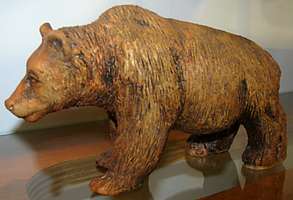
The Cavebear, though nominally vegetarian, would have been a formidable adversary if it was disturbed, or if their young were endangered. Cavebears may well have been encountered by nomadic hunters returning to caves for ritual or painting purposes, since cavebears overwintered in caves, and there is plenty of evidence of cavebears in the area at the time.
Photo: Don Hitchcock 2008
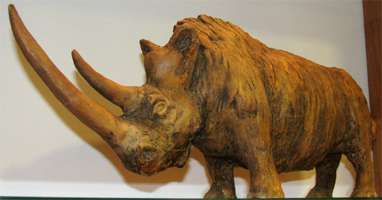
The Wooly Rhinoceros would have been the most dangerous animal of all during those times. Often alone, it was well able to defend itself, and almost certainly had a very aggressive response to any approach by humans. It was probably given a wide berth at all times.
Photo: Don Hitchcock 2008
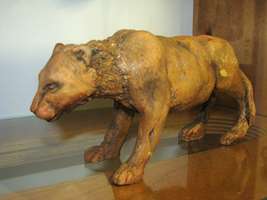
The Cave Lion was a huge animal. It was significantly larger than modern African lions. No doubt it was avoided where at all possible, as it would have regarded humans themselves as prey. A lone human would have had little chance against a Cave Lion.
Photo: Don Hitchcock 2008
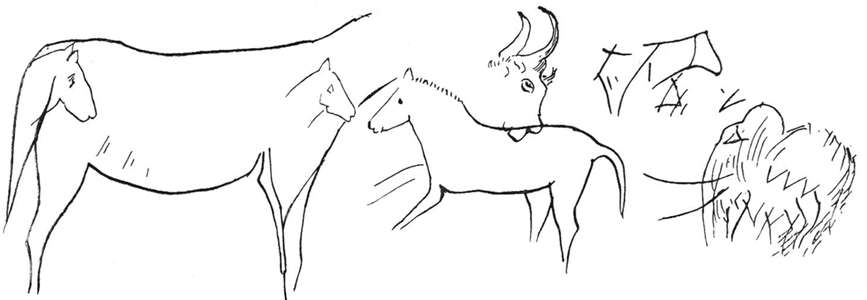
An unpublished engraving from the walls of Les Combarelles.
Photo: Capitan and Breuil (1902b)
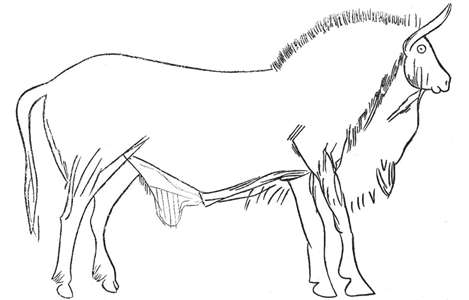
An engraving of a bovid with a mane.
Photo: Capitan and Breuil (1902b)

A reindeer in full flight.
Photo: Capitan and Breuil (1902b)
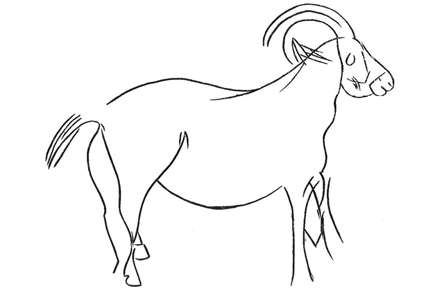
An engraving of an ibex.
Photo: Capitan and Breuil (1902b)
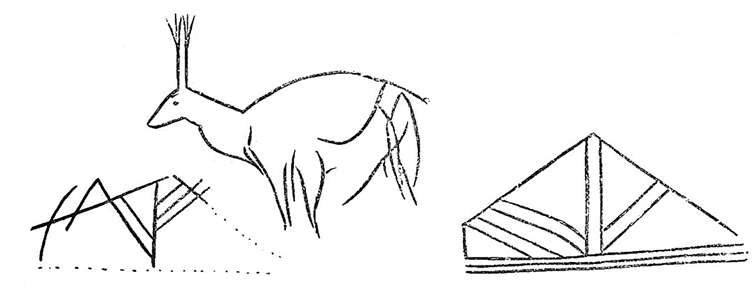
Two tectiform signs symmetrically placed. Between them, an engraving of a deer or antelope.
Photo: Capitan and Breuil (1902b)
Figures préhistoriques de la grotte des Combarelles (Dordogne)
Prehistoric figures from Les Combarelles in the Dordogne
In September 1902 we recognised on the walls of Les Combarelles 109 perfectly distinct figures, representing a series of engraved animals of various species, the entire animal or just the head alone.
We have represented all these animals on a strip which measures 12 metres long and 12 centimetres high, at about one tenth of the natural size, and we place these here for the eyes of the Academy, as well as 27 tracings of the principal figures.
These images engraved on the walls begin at 125 metres from the entrance.
The cave has the shape of a long winding corridor, with a height of 50 centimetres to two metres, and a width of 1 to 2 metres. They extend over a length of 100 meters on each side of the cave, almost to the end, which is 235 meters from the entrance.
Engraved sometimes deeply (4-5 mm) In the Cretaceous limestone, sometimes slightly more, sometimes enhanced with a stroke of black paint, these figures measure 25 centimetres to over a metre in length. Many are coated with a calcite coating measuring a few millimetres thick and acts as a glaze on the drawings, while in other points the calcite hides them completely.
The animals represented as entire are horses, bovidae, bisons, ibex, reindeer, and mammoths, not to mention unidentified animals, various heads, and many drawings unable to be interpreted.
These drawings are always executed in profile, and show the animal at rest or walking, sometimes running. Their technique is identical to that of engraved bone or ivory found in deposits from the Magdalenian period. They have a character of precision and skill, showing the constant concern to reproduce nature as it is, with no idea of stylisation. As for the engraved bones, it appears evident that the figures have been executed by the artists of the time as exact replicas of what they saw.
The horses have variable characters; some are reminiscent of the appearance of a mule, others are similar to modern horses, as may be seen on the copies we have presented here.
The bovids are equally varied, one in particular with its large dewlap, his little head and his quite thin body. Two reindeer above, which we present also as tracings are figures with a fidelity that can leave no doubt about their identification.
Two superimposed ibex have been very exactly reproduced.
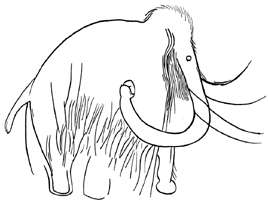
Finally, 14 figures show a variety of mammoths showing animals sometimes young and entirely covered with hair, sometimes older, and with less hair. All these images are of remarkable accuracy. Forehead, long hair, shape of the ears, trunk, legs, attitude, everything is represented with a special care that leaves no doubt as to the veracity of the identifications.
Photo: Capitan and Breuil (1902a)
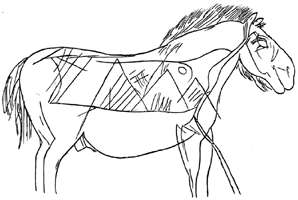
Four images of horses showed markings indicating clearly that the animals had been domesticated. Two had a covering on the back clearly shown, another presents a kind of band around the snout and a fourth has an indication evident on the cheek, a piece of reindeer horn, pierced with holes, formerly known as a baton de commandement, and that Piette has shown was a kind of primitive bridle.
Photo: Capitan and Breuil (1902a)
On the side of one horse, there is a diamond-shaped sign, circumscribed by two strokes; on the rump of another animal, we can see three signs that have the appearance of letters. This arrangement recalls the letters that are, on the same area, depicted on some archaic Greek depictions of horses.
Other noteworthy figures include two signs in the form of brackets inclined towards each other and are deeply engraved and behind a large very precise representation of a mammoth. These signs are very similar to those that Piette noted on engraved bones he considered as representing a signature by the artist or a mark of ownership.
These are several triangular signs, with oblique lines inside (tectiform signs) These may be a coarse representation of a head or a human skull seen from the front, and some cupules
The question of authenticity of these figures can not be within the shadow of a doubt. Their technique and way of reproducing animals already allows us to consider them very old, undeniably contemporary with the engravings on bones found near hearths for which the stratigraphy and fauna can be dated exactly and point to a bygone "era of carving" referred to by Piette or the Magdalenian referred to by G. Mortillet. Moreover, the accuracy of the figures speaks clearly to the fact that they had to be executed by artists who saw the beasts they represented, and lived with them.
Since these animals, the ibex and reindeer, disappeared from our land at the end of the late Magdalenian, while the mammoth disappeared probably even before the end of that period, it follows that these representations date from this period whose antiquity not able to be evaluated exactly, even in centuries, but only very roughly, and if we really wanted to have the figures they could be traced back to 10th or 12th millennium before our era and possibly even more remote than that.
These multiple manifestations of a precise art, sincere, true, equipped with a learned technique are all the more remarkable in that they appeared suddenly, already very sophisticated, and they disappear no less suddenly, without going through a period of decadence. There is then no more sign of them in subsequent epochs, and apart from a few stylised or symbolic examples here and there, they have disappeared.
The study of prehistoric art events on the walls of caves give therefore a view of a history of the origins of art.
This is of such great importance that we deemed it necessary to present this report of the results of our initial investigations to the Academy.
Les Combarelles II
Translation by Don Hitchcock
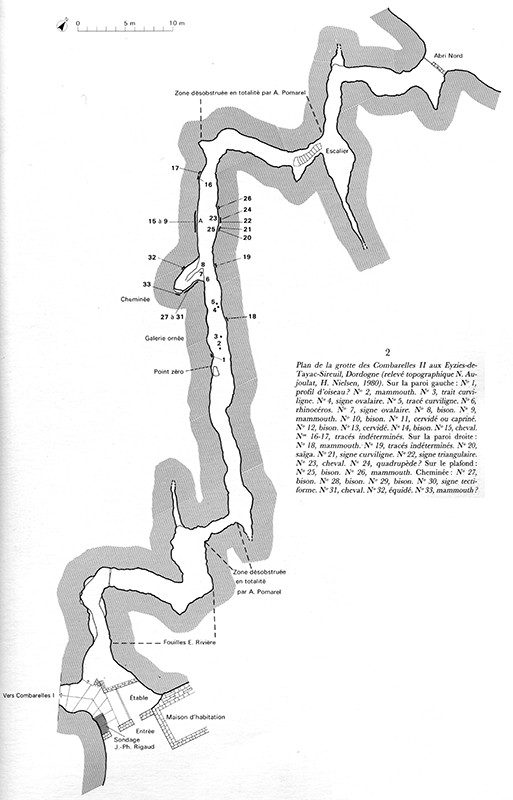
The plan of Les Combarelles II at left is by N. Aujoulat and H. Nielsen.
Les Combarelles II is no longer open to the public.
As we enter the porch, Les Combarelles I is to the left, and Les Combarelles II is to the right. The tunnels are similar in general character. For Les Combarelles II, there is a winding profile, with a slope of 8 metres over the 103 metres of the cavity. The cavity can be split into three sections, of substantially equal length. The first, of 35 metres, is very winding, and was the site of extensive excavations by E. Rivière. The second, of 36 metres in length, has a rectilinear layout, and includes all the known engravings of this cave.
A stalagmitic curtain obscured eastern access at the southern end of the two ended tunnel, near the present entrance to Les Combarelles I; a sandy-clay deposit clogged the western entrance towards the north of the tunnel, thus sealing, before the intervention of A. Pomarel, the two potential entrances to this cave.
The last 33 m is distinguished by its multiple floors and its numerous side chambers. This cave makes the hydrogeological junction between the valley of Les Combarelles and the valley of the Beune. Its entrance stands at the bottom of a large abri, facing the departmental road D47.
Originally, a large amount of fill clogged the entrance vestibule and partially obstructed the first thirty metres of this cavity. At an unknown time, this soil level was lowered to facilitate the establishment of a barn, under the porch. At the end of the last century, when E. Rivière undertook the excavation of the archaeological deposit of the right branch of Combarelles, it had been the subject of earlier research by Abbé Chastaing.
A sondage indicated to the latter the presence of a very rich Magdalenian level. During a meeting of the French Association for the Advancement of Science (August 11, 1894), E. Rivière reported on the results obtained during the campaigns from 1892 to 1894: 'We found a considerable quantity of cut flints which were in the thousands. two bone harpoons, one with a row of barbs, the other with two; needles, awls, spear heads with large bevels, pierced teeth and shells, engraved bones ... ' (Rivière, 1894).
Although these objects have no stratigraphic identity, their belonging to a Magdalenian culture is attested in particular by a harpoon with double row of barbs (upper Magdalenian), and a bone rondelle, with two holes, decorated with radial incisions (Middle Magdalenian).

Entrance to Les Combarelles II.
Photo: Don Hitchcock 2008
During the course of a sondage, located on the left of the first steps of the access staircase to Les Combarelles I, J.-Ph. Rigaud, in 1968, collected stone tools which confirmed the occupation of the site in the Middle Magdalenian. Originally, the diverticulum on the right was interrupted in the axis of the gallery only by a very narrow vertical crack. In their monograph (1924) devoted to the Combarelles, L. Capitan, Abbé H. Breuil and D. Peyrony already noticed the possibility of an extension at the foot of the right wall, a few metres from the bottom, and noted: 'it is quite probable that excavations pursued at this point would reveal... a certain length of filled corridor, and if the ground rose, perhaps another practicable gallery' (Capitan et al., 1924)
Probably taking into account these observations, A. Pomarel, in 1934, opened, through a filling of ossiferous breccia and clay, a passage giving him access to the decorated gallery. The careful observation of the walls led him to discover the first engravings of the cave. They were authenticated shortly thereafter by D. Peyrony, then partially recorded and published in 1952 by Abbé H. Breuil.
Description of the figures:
Before its excavation, the corridor of linear axis was barred in its median part by a stalagmitic flow. The first engravings appear one metre from this bottleneck, initially difficult to cross. They are distributed on the left and right walls, on the vault, and inside a chimney. The description of the figures will be in this order. The reference point, or zero point of the planimetric positioning of the works, is located downstream of the end of the concretion.
With reference to the zero point, and on the left wall:
• At one metre, a rock outcrop somewhat altered, suggesting a profile of bird (1)
• At two metres, a finely incised contour of a mammoth, obscured by a calcite veil (2)
• At two meters fifty cm, a curvilinear line (3)
• At five meters ten cm, an oval sign engraved on a cornice (Fig. 8) (4)
• At sixty centimetres to the right of the preceding, a second curvilinear line (5)
• At ten metres, a Rhinoceros tichorhinus (woolly rhinoceros), length 66 cm (6) surmounted by a small oval sign (Fig. 5) (7)
• Fifty centimetres separate this last from a bison of a substantially identical size (8) (Fig. 4);
• Located on the same horizontal line between fourteen metres and sixteen metres, an engraved sequence of several animals and signs (A). They are, in order, as follows: a mammoth (A 9), a first bison, seen from the front (A 10), a cervid or goat (A 11), a second bison (A 12), whose head seems to take the place of of a reindeer or deer (A 13), followed by a third bovine (A 14). The front hoof of a horse (A 15) completes the composition of this frieze (Fig. 3)
• Four metres further on, two engraved panels, with uninterpretable tracings, put an end to the decoration of this wall (16-17).
On the right side:
• At four metres ninety cm, a very altered mammoth profile (18)
• At ten metres eighty cm, a panel incorporating several curvilinear and rectilinear lines whose meaning remains to be defined (19)
• At three metres further on, a Saïga antelope and a curvilinear sign (Fig. 7) (20-21)
• At fifteen metres, a triangular sign (22)
• At fifty centimetres further on, a horse with a static rear hoof, a raised front hoof, and with a 'goose rump' or 'jumping rump' (a rump which inclines sharply downwards, the slope of the pelvis being significantly greater than 30 degrees with the horizon) (Fig. 6) (23).
The sequence on the right ends on an indeterminate figure, at sixteen metres seventy cm (a ruminant according to Breuil) (24).
Two engravings adorn the ceiling of the gallery, one located at fifteen metres forty cm, the other at seventeen metres thirty cm. The first is similar to a bison head traced on a rocky outcrop whose ridge marks the edge; only the eyes and horns have been incised (25). The second, inserted inside a concavity, could be identified as a mammoth (26).
At the level of the rhino-bison pair, a subvertical chimney was decorated with three bisons (27-28-29) (Figure 1).
Turned to the right, they occupy the corners of an imaginary triangle, the point of which is directed downwards. A sign comparable to a tectiforme precedes the juxtaposed bovines (30). Inside the outline of the bison adjoining this figure is the head and neck of a horse (31). On the opposite wall, a second sketched equine (32) (rump) complete the decoration of this chimney. The current layout of this vertical duct did not allow us to confirm the identity of a figure placed at a high level (10 metres), which could be a mammoth (33).
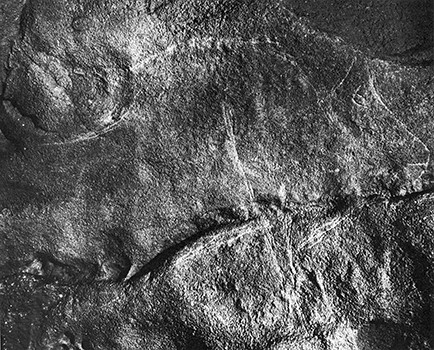
Bison number 28
Photo: Norbert Aujoulat, in Leroi-Gourhan (1984)

Panel A, left side.
Photo: Norbert Aujoulat, in Leroi-Gourhan (1984)
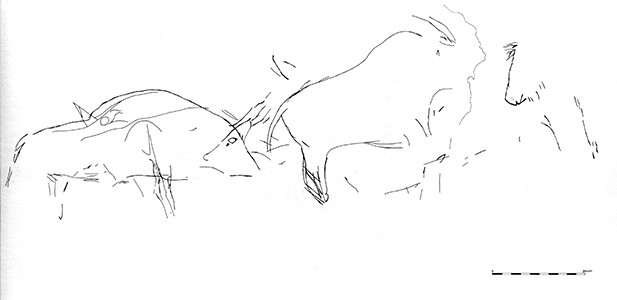
Panel A, right side.
Photo: Norbert Aujoulat, in Leroi-Gourhan (1984)
Conservation
The commercial exploitation of a cave inevitably and irreparably affects graphic wall representations. These degradations occur during successive developments, visits, or when the site is abandoned. Les Combarelles II has undergone these three phases. Although the opening to the public was episodic and the groups formed in each case were small, the fact remains that the rubbing of clothes on the walls has greatly altered certain areas more exposed than others, especially the Rhino-Bison pair. It was threatened by the very sensitive action of a current of air caused by the removal of the filling at the two ends of the decorated corridor. An effective closure has recreated the initial and ideal conditions for conservation.
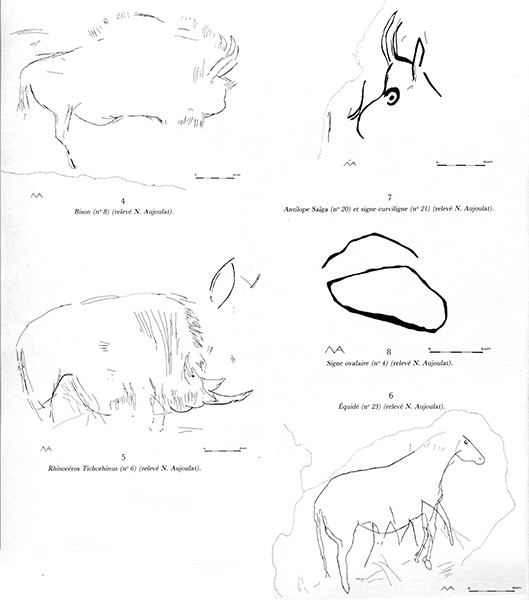
Various engravings.
Photo: Norbert Aujoulat, in Leroi-Gourhan (1984)
The paper I have translated below represents a huge and very valuable piece of work, in the very highest traditions of research and scholarship. This result of the many thousands of hours that the opus must have taken, both underground and in later analysis, deserves a larger audience.
Les Figurations Humaines Pariétales de la Grotte des Combarelles
par Monique et Claude Archambeau
Translation: Don Hitchcock

Map of human figures on the walls of la Grotte des Combarelles.
Photo: Archambeau (1991)
Abstract
A study of the fifty human figures known at Combarelles were used to set up a typology. The chronological situation of the drawings has now been accurately determined. The human figures are regularly associated with the animal most frequently represented in each cave. We believe that they may constitute evidence for an anthropocentrism, which could be at the centre of a new overall theory.
The large number of human figures contained in the Combarelles cave is an exceptional fact in parietal art . The study of this set allowed us to make a typological and chronological classification of them. Their distribution in space as well as the representations which are associated with them can have value here as a model, given the sampling and the duration of frequentation of this cave (fig. 1).
When it comes to human representation, we come up against two difficulties. The first belongs to the Prehistoric people themselves because they have always voluntarily represented the human being in a schematic way and this particularly in the Magdalenian. The second can be summed up in terms of anthropocentrism. First of all, anthropocentrism of Cro-Magnon men who seem not to have escaped what constitutes the very foundation of our 'humanity'. Secondly, the anthropocentrism of the prehistorian who reads and interprets the symbolic environment of human representations with its culture and its morality. As much as the reading of horses, bison or mammoths may seem simple, the interpretation of human figures is more difficult. Proof of this may be taken from the fact that led Abbé Breuil and his peers to omitted to include human representation in figurative animal art, when he himself had identified a large number of them both at Combarelles and in other caves.
If there is to be a new attempt at a synthetic study of prehistoric parietal art , it will be necessary to give its rightful place to human representation. In order to preserve our readings from any abusive interpretation, we will call human figure a representation which includes at least one character specific to the human being. We have thus taken into account the following characteristics, which seem to be the canons of representation :
• the rectilinear dorsal-lumbar line
• the 'carrying of the head' in the extension of the back on a slender support, the neck
• the biped position
• both eyes seen from the front
To these main characters, which allow us to identify humans, we add secondary characters already used by L. Pales to determine sex when possible:
• male sex - Adam 's apple, facial hair and penis
• female sex : breasts, large belly and vulva
Knowing that realism can not be a criterion of determination by definition, and since it is necessary to use the right word and not the abusive interpretations of our predecessors, we will eliminate from our vocabulary the terms of anthropomorphs, hybrid animal , sorcerer, mask ...
Statements
The engravings from the Combarelles cave, like all engravings in general, are not easy to identify, particularly for questions of the evolution of surface states and patinas. We will not develop here the different conservation conditions depending on whether they are engravings or paintings.
As a general rule, in the decorated caves, the engravings are numerous and superimposed. In order to make our interpretation as objective as possible, we have developed a survey method consisting of an orthonormal reference of definitive and juxtaposable dimensions, thus systematically squaring the wall (Archambeau, 1982 ).
The measurement of the third dimension, which we obtained from the frame to the wall, allowed the construction of level curves indicating the inclusion of the figures in the reliefs. These two stages of the survey are perfectly superimposable, since they are carried out according to the same metric reference.
At Combarelles, the representations which are continuous on the walls allow the reassembly of the various readings carried out from 50 cm to 50 cm, which makes it possible to codify all the features contained in this fixed space . We proceed as by stripping the wall according to the different levels of intervention.
We used the straightness of a beam of light placed perpendicular to the frame and then noted the discernible features on a sheet of non-deformable glass. Our mobility as well as the mobility of light are essential to distinguish the different lines on the walls of the Combarelles. It seemed very important to us to publish readings located in space, which are therefore controllable and reproducible.
This close reading of the walls has identified about 200 new representations, including 15 human figures, and we are still discovering more. In this context, Father Breuil's numbering , which is still the only one used to this day, constituted a limit to identification in his inventory. We got around the difficulty by building a drawer system , based on its numbering by panels.
Systematic study of human representations
We present here the statements according to the different stages of wall analysis. Some statements are made with a single line and indicate a state of conservation that does not allow an analysis of the line, but their reading remains possible.
Other statements are made in two stages: first a synthetic reading of the human figure and its immediate environment, then an analytical reading of the human figure alone, each time it is possible to note a particular impact of the representation technique. We will indicate, in this case, the thickness of the lines, their section, their inclination and their depth.
Finally, some statements must be superimposed on the level curves , in order to understand the framing in space and the use of the forms of the walls.
Figure 2.
(MCA stands for Authors' New Discovery)
Photo and text: Archambeau (1991)
N° 0-1 : Geometric type human representation (fig. 2)
This engraving, located on the ceiling, is the first identifiable representation currently known in the cave. It is located 3 m before the first panel indicated by Abbé Breuil and about 67 m from the door.
In the case of such a schematic representation, the determination of a human is difficult. However, it is by analogy with other figures of the same type in the cave that we can advance an interpretation. The use of canons is applied here: the very arched dorso-lumbar line is made in a single line up to the extension of the thigh and the ventral line is very schematic.
In the particular case of geometric type figurations, the dorso-lumbar line can only be that of a human. Indeed, the very straight back , the very accentuated lumbar arch and the prominent buttocks form a curved line that can not be confused with the cervico - dorsal line of a bison or a horse.
This type of representation is usually female, but on this figure no character allows us to identify the sex.
Figure 3.
N° 3-1 : Geometric type human representation (fig. 3)
In this area, it is not possible to find Abbé Breuil 's interpretation. It is true that a few scratches, probably due to the old work of lowering the ground, may have destroyed certain features. Nevertheless, taking into account all the engravings existing at the place where Abbé Breuil saw the front legs of reindeer n° 3, we identify the thigh of a schematic female figure of geometric appearance, which resembles. many in n° 11-2 (see below p. 58), while a relief was used to symbolise the chest.
The belly is bigger than in other geometric figures but the principle of construction from a stereotyped diagram is respected. This figure has no head or arms. Next to it, despite a difficult reading due to the flakes and a calcite flow, we can recognise the cervico-dorsal line of a horse.
Photo and text: Archambeau (1991)
Figure 4.
No. 4 : Enigmatic representation (fig. 4)
The conservation of surfaces makes it difficult to read this figure. Since Abbé Breuil's readings, clay has been rubbed on the wall, which has considerably degraded certain features that were already poorly preserved.
Today we only see one eye for sure and no ear.
A few lines seem to represent the right arm, but everything in this figure is schematic. However, a human representation is recognised by the general position of the body and the leg and the 'carrying of the head'. The reading of Abbé Breuil, who identified mammoth tusks starting from the head, is attractive, but the quality of the support does not allow us today to be so precise in determining these appendages. However, our reading remains consistent with Father Breuil's general interpretation.
The evolution of the conservation of the support, aggravated by thick calcite flows, does not allow us to judge the choice of the location that the engraver was able to determine.
This is the reason why it did not seem necessary to construct the level curves for this figure.
In this particular case, if one day we must speak seriously of masked men, we will certainly have here an example as convincing as the 'Horned God' of Les Trois Frères.
For the time being, we place this figure under the heading of enigmatic representations of human figures.
Photo and text: Archambeau (1991)
Figure 5.
No. 11: Indeterminate (fig. 5)
Abbé Breuil classified this representation among the probable and vague human figures because its statement could suggest a silhouette.
A more systematic reading of each feature suggests an organised whole but it is impossible to attribute any human character to it. We have recognised in the cave other representations whose structure is close to this one, which are perhaps organised signs, such as, for example, the set of curved lines which are just to the right of this figure.
Photo and text: Archambeau (1991)
Figure 6.
No. 11-1: Geometric type human representation (fig. 6)
This human figuration was discovered by Claude Archambeau in 1978.
Abbé Breuil did not see this figure or the following one, certainly because they are in a very low area at the level of the old ground. Indeed, the mattress of branches on which he was supported above the puddles of water must have covered these figures, however obvious.
This representation of geometrical appearance is close to n° 67 (1) (cf. infra, p. 70) very well known at Combarelles. This figure, like those that resemble it, seems to be made with large, sure strokes, without repetition, like a stereotyped pattern. Its feminine character with a strong breast is absolutely clear.
It would be a representation, with only one breast, in absolute profile except for the small
protuberance that ends the breast and that could be a representation of the nipple. The location of this figure in an area of dangerous passage for its conservation has contributed to the wearing away of some clayey parts that could suggest a voluntary patina.
Immediately to the left of this figure and partly above it, another set of lines seems organised. The reading is difficult because the lower part of the features is very degraded. However, with intense lighting, we seemed to recognise the thigh of another human representation, without head, whose back would be drawn on the usual model of the curved line.
The two ovals would represent the opulent breasts of a woman seen from a three quarters viewpoint. The line that draws the thigh is very degraded by splinters of calcite clay, so that it is almost impossible to determine if it is a degraded line or an effect due to the relief. We will therefore not retain this reading in our count of human figurations.
Photo and text: Archambeau (1991)
Figure 7.
No. 11-2: geometric type human representation (fig. 7).
This is a human figure located 20 cm to the left of the previous one (n° 11-1) and discovered at the same time by Claude Archambeau.
These two figures have a 'family resemblance' but they are totally different in their way of representing humans. The feminine character of this representation, without a head or arms, is evidenced by a swollen belly and a voluminous breast rendered by the use of natural nodules. By its shape and the use of a natural relief for the realisation of the breast, this representation is to be compared to n° 3-1.
The rock here is very flaked and, as far as the preservation of the line is concerned, it seems that the engraving is posterior to the flaking of the hardened clay, unless what can be seen has happened as at les grottes du Ker de Massat in Ariège, the figures engraved on clay were made with a sharp tool, so that when the clay flakes off as it dries, the line remains on the rock below. It is regrettable that the lower part of this figure was obliterated by mortar applied during the installation of electrical wiring.
Photo and text: Archambeau (1991)
Figure 8.
N° 19-1: Geometric type human representation (fig. 8).
Abbé Breuil had noted these features, which he called 'parasites', on horse n° 19, covered with several horizontal or oblique lines. We propose to interpret them as a human figuration, due to the balance of the silhouette. We discern a trunk with two arms apart, the arm placed on the right draws an arc of a circle, while the other is folded. The head and legs are not identifiable. We therefore read a human figure, without distinction of sex, seen from the front or from the back, whose character is rather geometric.
The similarity of representation with certain human figures on plaques found by G. Bosinski in Saalfeld is surprising. In this example, three characters identical to that of les Combarelles seem to be holding hands.
Photo and text: Archambeau (1991)
Figure 9.
N° 27 (1): Undetermined (fig. 9)
This figure is not on the ceiling as Abbé Breuil had indicated, but 250 cm after mammoth n° 26, at prehistoric ground level.
In this part of the cave, the support is poorly preserved. Indeed, the absence of a calcite crust makes the rock fragile. It is therefore very likely that the conservation conditions have damaged the features of this figure.
It is an incomplete representation, without an eye, whose nose is included in a relief. Only the 'carrying of the head' could make us classify it among the human representations; which, although Abbé Breuil described it as 'distinctly human', is not, in our opinion, of a sufficient character for that classification.
Photo and text: Archambeau (1991)
Figure 10.
N° 27 (2): Undetermined (fig. 10, no. 1)
With regard to this representation, it is difficult to follow Abbé Breuil in his interpretation. Perhaps we could place this organised figure in the series of 'undetermined' that Abbé Breuil seldom used for Les Combarelles whereas he used a lot of the term 'masks, fantastic'. It could also be a 'sign'.
N° 27 (3): Expressive human representation (fig. 10, no. 2)
This figure is included in the hindquarters of a very schematic and disproportionate horse.
Although deformed, she has aspects that can be human: like the 'carrying of the head' on possible shoulders. But the profile is very surprising, it goes beyond the prognathism ( protrusion of the lower jaw - Don ) often depicted in this cave, and is rather reminiscent of the head of a bird.
Photo and text: Archambeau (1991)
Figure 11.
N° 31: Realistic human representation (fig. 11)
In this representation, we find with certainty the thigh, the leg and the foot of a human in a seated position. On the other hand, the body is questionable. Abbé Breuil saw a body leaning forward because he was taking into account features that he 'hardly isolated from many parasitic features'. The representation of the eye which could bring some credit to this reading does not actually exist, they are only portions of lines and cracks: nothing confirms its existence.
The nature of the support, clay of decomposition which forms a striated and calcified veneer, is the only argument which makes it possible to imagine the lines in continuity. These are not engravings. The state of preservation of this portion of the wall makes it difficult to read and therefore interpret these different features.
We propose another reading which takes into account the nature of certain deeply engraved lines and associates them by technical assimilation with the lines of the thigh. This hypothesis shows a straighter body than in the previous case. The position remains correct for a seated man.
But the features forming the body are in fact the hind legs of horse n° 30, associated with some reliefs and cupules which can be interpreted as a head. Only the invoice of the features, which thus isolate themselves among the others, allows the identification of a human. To conform to our definition of the representation of man and following Abbé Breuil's first interpretation, we will only take into consideration this lower limb in a seated position which is very characteristic of the human figuration; we will consider this document as expressive figurative.
As always in the Palaeolithic, the foot is a simple outline. The expressive character of a lower limb corresponds to an exceptional representation to which is added the sitting position. Known seated representations are often on the ground (cf. n° 32-1). It is also necessary to underline the relation of this figure with the representation of the horse. The man seems included in a group of horses. Thigh, leg and foot are drawn on a fairly smooth surface while the surrounding surfaces are less regular. As very often at Combarelles, the engraving is located on the most suitable flat surface.
It is not impossible to conceive of a voluntary visual phenomenon which could have a symbolic value, concerning the use of the hind legs of the horse as the body of the seated man.
This remark has been made on other figures (cf. n° 45). Prehistoric people voluntarily
used parts of representations to make others, certainly not for the sake of economy of line. The recognised association of man and horse here is frequently found at Les Combarelles.
Photo and text: Archambeau (1991)
Figure 12.
N° 32-1: Geometric type human representation (fig. 12)
Its geometric design and the outline of a single line bring this figure closer to nos. 67, 3-1 and 11-2.
It seems that this female representation, very arched, with a prominent breast, although only suggested, is in a seated position, which is surprising for this type of representation. It is usually called 'the Venus of Tursac' by analogy with the eponymous Venus, mainly because of its position and its arched and slender appearance.
This figure fits in the neckline of horse n° 32.
Photo and text: Archambeau (1991)
Figure 13.
N° 36-1: Indeterminate (fig. 13)
Abbe Breuil saw a bear's head in this face. However, the representations of bears remaining doubtful at Combarelles, he often wavers between an attribution to a bear or to an anthropomorph.
Here, it is difficult to find the figure of the bear, given the important selection he made of the features. By trying to take into account all the features, figured against the front legs of reindeer n° 36, we can discern a muzzle and a neck with a possible, although very schematic, horse's head. Just in front of this muzzle, an organised figure resembling a frog or toad seems built around a large disproportionate eye. We say 'human' by analogy, but the interpretation remains enigmatic.
Photo and text: Archambeau (1991)
Figure 14.
No. 42-1: Human head (fig. 14)
It is a figure organised around the reliefs of the ceiling vault, which is relatively disordered. The features are angular, deeply engraved; they accentuate the natural form of the reliefs and integrate others as if the Magdalenians had seen the figure by its reliefs alone, and had then engraved it to make it more real. The eye is a natural cup that has been slightly abraded in its upper part.
A rock prominence suggests an upper jaw. The shape of the relief is perhaps the origin of a prominent lower jaw, which is not very anatomic for a Cro-Magnon, but is frequently represented. The relief also suggests an occipital chignon that the graphics have not corrected; here again there is a similarity, for example, with certain figures from La Marche.
It is a very realistic figuration although accompanied by primitive human characters or perhaps only exaggerated by the form of the natural relief used under the same conditions as for the animal representations. It is located above several horses.
Photo and text: Archambeau (1991)
Figure 15.
No. 42-2: Enigmatic representation (fig. 15)
The cephalic drawing of this figure gives it a certain human character but the whole remains enigmatic. The very exaggerated prominence of the lower jaw is very reminiscent of n° 82. The eye here is well marked; it seems to be an important part of the representation.
The organisation of the lines figured around the reliefs makes the overall reading difficult. It is above all the general aspect of the support, associated with the lines, which makes it possible to interpret this figuration. The proximity of n° 42-1, twenty cm before, whose technique is identical, allows a reading by analogy. This figure, like the previous one, is located just above two horses.
Photo and text: Archambeau (1991)
Figure 16.
No. 45: Realistic human representation (fig. 16)
Abbé Breuil saw in this representation 'lines that had remained misunderstood'. However, in his concern to spot highly figurative animals, he eventually interpreted them as the two front legs of a horse. No line can represent the shoulder of this beast.
On the other hand, the formation of the deeply and largely engraved lines, as if enlarged in a U to accentuate them, seems to show a standing human silhouette, seen from the back or from the front. The hips are well marked, the legs have a very human movement, the leg placed on the right is extended by a finger appendage finely engraved.
In the reading, there is nothing to associate it directly with this human representation, but it is indeed an organised symbol. The absence of a head is not a problem. We know, in fact, a large number of headless representations in prehistoric art.
The ibex superimposed on the horse has its head precisely above the body of the human representation. Very deep strokes are deliberately continuous from the top of the body to the bottom of the legs. One can think that after the realisation of the animals, the appearance of a human body was such that a Magdalenian cut deeply into the rock to make the contours appear. The ibex was drawn first, the horse was made later, then many lines came to obliterate these two figures and it is from these lines that we see the voluntary widening of the incisions revealing the human figuration.
It seems that the only feature, the dorso-lumbar line, which was missing to express this silhouette, was made after the animal figures. The Magdalenians therefore deeply recut all the parts that could make it possible to recognise a human body. It is also necessary to note this very frequent association of man and horse. The level curves of this portion of support showed us that the human representation was precisely engraved on the only roughly flat part: it occupies it entirely between two concave parts which represent the bellies of the horse and the ibex. As in the case of n° 31, there is reuse of a part of the horse's body (the front legs) to express the legs of the human subject.
Photo and text: Archambeau (1991)
Figure 17.
No. 48: Expressive human representation (fig. 17)
We classify among the human representations a figure that Abbé Breuil had interpreted as a small bison. It seems difficult to follow him down this path. Despite a significant thickness of calcite, it is possible to recognise a head, the cervico-dorsal line and the representation of a shoulder.
The nose seems well noted and the eye is obvious. At the level of the shoulder, one can note the beginning of an arm. The whole gives this figure a somewhat fetal but very human form. A set of streaks on the body is associated with it and can be compared to a set of identical lines on n° 31. The forward leaning position is unrealistic but frequent in prehistoric human representation.
This figure is located under the belly of a large horse. We rank it among the expressive figurative representations.
Photo and text: Archambeau (1991)
Figure 18.
N° 62-1: Geometric-type human representation (fig. 18)
This representation is similar to n° 0-1 by its succinct character: an absolutely rectilinear ventral line, no feature suggesting a breast, usually represented to emphasise the feminine character of this type of figuration. The dorsal-lumbar line respects the classic pattern: the very straight back is a human character, with very arched loins and well-endowed buttocks. The representation seems stylised.
A vertical line under the thigh seems to have been drawn to express the outline of the leg; this detail makes the figure even closer to the human scheme, despite its abstract character. The few lines placed above the back suggest a horse's mane.
Photo and text: Archambeau (1991)
Figure 19.
N° 63: Enigmatic human figure, profile view (fig. 19)
The tracing of the back and thigh recalls geometric type figures, but the representation is not very detailed. The beginning of a head uses a tormented relief; all of the ventral part is retracted. It is not possible to determine the sex. Once again only the dorso-lumbar line could identify a human, with perhaps the 'carriage of the head'.
Breuil spoke only hesitantly about the 'shield sign' on the left. We can today identify it as a vulva by comparison with a certain number of Magdalenian representations of the same kind. The vulva appears to be posterior to all other features.
A horse's head is still legible nearby, but very little remains of the black paint reported by Breuil. It is on a convex wall, and friction due to the passage of visitors has considerably degraded the painting.
( I can find a horse's head on the left, and what may be a small human head on the right with what may be its back and rump and part of the back of a leg, but I find this description as a whole to be quite opaque. I am obviously missing something - Don )
Photo and text: Archambeau (1991)
A vertical line under the thigh seems to want to express the outline of the leg; this detail makes the figure even closer to the human scheme, despite its abstract character. The few lines placed above the back suggest a horse's mane.
Legend:
Fig. 20 - Expressive human figures nos. 64 (1) and (2):
a, the traces as they can be seen in the photographs taken under different lighting;
b the whole as depicted by Abbe Breuil;
c, the two hind legs of herbivores and the horse's head which can be isolated with certainty;
d, remainder of undeciphered lines (after Leroi Gourhan, 1965, p. 483, fig. 803).
Photo and text: Archambeau (1991)
Nos 64 (1) and (2): Expressive human figures (fig. 20 and 21)
Abbé Breuil saw in the subject on the right a female figuration. But the breasts are not obvious and the abdomen is not typical of a pregnant woman. It is therefore difficult to identify the sex of this figure, but it is indeed a human figure, realistic in view of the silhouette, and which is superimposed on the neighbouring male figure. This represents a man leaning forward, to the left, with a fairly well-proportioned body.
The erect penis is obvious, the arms are stretched forward. If the hands have been represented, their rendering remains very schematic. The head is partly covered by a flow of calcite which nevertheless allows the reading of a few lines. It is impossible to see, due to the thickness of the calcite deposit, if the eye is a simple cupule or if it has been retouched. This character's large abdomen is amazing, given his obviously masculine nature. Obese male representations are indeed very rare, nevertheless the human character of this figure is not in doubt. This set is to be classified in the group of expressive figurative humans. The contour lines confirm that the second representation is inscribed in the flattest part of this rotunda, while the human superimposed on the right, with its back against the thigh of the larger figure, has been engraved in a prominence of the relief.
Leroi-Gourhan gives a different reading of this set. From photographs, he isolates a horse's head on the right, which actually exists (see n° 63), then two hindquarters of herbivores. For this, he makes a selection of lines much larger than that made by Abbé Breuil. It is surprising that such a large number of organised features are not indisputably associated with a figure.
This is thus an exceptional case in the figurative context of the Combarelles. Despite the large number of overlaps, we generally manage to identify the representations. Often, the technique of the line facilitates this reading. In the interpretation made from photos, the man's abdomen line appears to consist of several lines, when in fact it is a continuous line. The design of the phallus practically does not extend, and the longest line is the one above.
The right foot of man is denoted by the instep and the heel in a very human morphology; it is not a shoe at all. The dorsal line of the man shows several corrections, but it is a continuous line. The curve located at the height of the shoulder indicates the left shoulder, but it does not extend beyond the line of the back.
Aligned cupules give us, in a photographic approach, the impression of a line. Finally, the line of the neck which constitutes the 'carrying of the head' of the man is quite straight and in line with the back, which is also straight. It is difficult to see in this line that of the cervico-dorsal line of a horse. This example is characteristic of the problems associated with photography in the case of a substructure like that provided by the walls of les Combarelles. It is not only necessary to control the angles of lighting but also to protect oneself from interpretations of relief, from small naturally aligned holes which can be wrongly perceived as intentional, and from the conditions of conservation of the lines, which are very poor.
Certain features seen by Abbé Breuil are no longer legible today and it is therefore difficult to comment on their interpretation. It should also be noted that he sometimes 'let go' of his pencil. Currently, some figures are no longer discernible at all as he depicted them. Finally, photography does not allow modern lines to be identified on a support as badly preserved as the wall in this part of les Combarelles: this is the case with the two lines read by A. Leroi-Gourhan, in the abdomen of the man.
Our reading is therefore that of two superimposed humans, an indisputable man and a human of indeterminate sex whose back is common to the thigh of the previous one.
Photo and text: Archambeau (1991)
No. 64 (3): Enigmatic Figuration (fig. 22 and 23)
The only thing that allows us to identify a human here is the 'head carriage' of this figure, which cannot belong to any animal. Moreover, the general silhouette is that of a bipedal being leaning forward. Abbé Breuil evoked the possible representation of a woman, taking into account the appendix located in the posterior part of the figure. He compared it to a representation of the Sud Oranais people; but in this case the appendix was placed anteriorly. The argument is weak to identify the sex under these conditions. There is no visible breast; only a big belly, quite low, could be that of a pregnant woman, but this only clue is too slight to symbolise sex.
We will have to limit ourselves to the identification of a human figure very close to the preceding man, both in the same position. But it will be necessary to abandon the seductive image of an 'intimate scene'.
On the other hand, it is interesting to note the presence of organised lines, which could well be signs on the stomach, and a grid traced in front of the figure at the level of the pseudo-arms, badly represented. In this representation, the eye is formed by a natural cupule made by man. The lower part has been scraped to lower one side. 'This erotic couple from the Combarelles', according to the formula of Mme Saccasyn Della Santa, has disposed certain authors to imagine much more than the scene represents with certainty. It is not accurate to speak of a 'vulvar deployment' about this appendage located at the back of the buttocks. Indeed, the whole is not realistic and any interpretation in this direction is the fruit of the modern imagination; but we know nothing of the Magdalenian imagination.
Photo and text: Archambeau (1991)
No. 66: Human heads facing each other (fig. 24)
These two figures are included in the belly of a horse.
The profile on the left is realistic, its utter prognathism does not exceed the limits of the plausible. The eye is well placed, the 'head carriage' well represented; only the occipital part is neglected. Despite the appearance of a male profile, no hair that can confirm gender is represented with certainty. The poor conditions of conservation of the support, to which are added modern degradations, make reading difficult.
What Abbé Breuil interpreted as a second head on the right, facing the first, is today of dubious reading. The features he took into consideration are still visible, but it is difficult to read a human representation there. The eyes are simple cupules; there is no well-marked facial profile. It is by selecting isolated features that it would be possible to recognise a maxilla and an occipital profile. There is no certain neck. Faced with all these indecisions, it seems difficult to retain the hypothesis of a human head.
Photo and text: Archambeau (1991)
No. 67-1: Geometric-type human representation (fig. 25)
We recognise in this work the method of representing humans in broad strokes. The thigh seems to have been made by considerable rubbing on the soft clay on the surface. The difference in the deposit of the calcite is clearly visible, but the general evolution of the support has standardised the representation, so that it is difficult to detect the entire manufacturing process. Sex identification is impossible here.
Photo and text: Archambeau (1991)
No. 67-2: Geometric-type human representation (fig. 26)
The line of the dorso-lumbar line is very clear and the belly is rendered by a large rectilinear scraping.
This figure is located precisely above and between what Abbé Breuil interpreted on the right as a 'schematic phallus' and on the left as a 'possible vulva'. We also read there a characteristic triangular formation, also present, just like the tectiform signs, in Font-de-Gaume and in Bernifal.
Photo and text: Archambeau (1991)
Nos 67 (1) and (2): Geometric-type human representations (fig. 27)
In 1924, Abbé Breuil suggested this interpretation. He thought, in fact, that they were human representations with animal heads. We do not see today what image he could build from these features, because we are completely convinced of our reading. Indeed, the great resemblance between these figures and those of Lalinde, Couze, Gönnersdorf, Andernach, Fontalès, Hohlenstein, Le Courbet, Murât, Le Rond-du-Barry and many others, as well as with certain statuettes of same genus known as far as Siberia (Nebra, Oelknitz, Garsitz, Petersfels, Arlesheim, Pekarna, Mezin, Meziric, Dobranicervka), authorises us to confirm our reading.
On the right, the female image is very easily identifiable. Note the crossed sign on the buttock, often associated with this type. The second, to the left of the first, is more difficult to read because of its almost perpendicular position. She has a big belly and the start of a breast. Finally, to the right of this figure, we read the representation of a certain but astonishing vulva; because, if we add the upper curve of this vulva to the two lines of the female back, we read three parallel lines and by associating the line of the thigh to it, we have here three absolutely identical representations. The differences are only in the ventral lines. The vulva would be an extrapolation from the female representation.
If we examine in particular the features that make up the dorsal-lumbar curves of these figures, we seem to recognise the 'coup de patte' or recognisable strokes of one and the same artist who applied here the classic scheme in the rendering of these curves. However, the other lines are all different. It should be added that it is very difficult to make an analysis of this type because of the conservation conditions of the engravings at Combarelles.
The vulva, so close to the two female figures both technically and topographically, is not a special case at les Combarelles. In this cave, we find it at numbers 63 and 80, where there seem to be two on the left wall just above the human heads on the ceiling. These examples alone will not be enough to build a theory, but it is important to
point out the relation: human figures-vulvas which could be supplemented on occasion by new readings of parietal representations.
Photo and text: Archambeau (1991)
No. 67 (3): Enigmatic representation (fig. 28)
Abbé Breuil compared this small engraving, which seemed to him to be 'childish', to the figures of Marsoulas.
This frontal representation is limited to the head and shoulders. The slender neck widens at the shoulders. Its general appearance may suggest the schematisation of a human figure, but its unrealistic character and the very poor preservation of the features make it difficult to read and lead us to class it among the enigmatic examples.
In Marsoulas, there are eight representations of this type which allow, by comparison, a surer identification. This 'ghost' of the Combarelles is an isolated case among a large number of other representations, which are also very schematic.
Photo and text: Archambeau (1991)
N° 67-3: Geometric-type human representation (fig. 29)
This engraving, located above the other numbers 67, was made on a small flat part of the very irregular ceiling.
Here we find the usual way of constructing this type of figure. The incision of the line, very angular, allowed its good conservation under the calcite which later covered the engraving. One of the lines, placed at the level of the belly and partly emphasising a relief, could suggest a pregnant woman. But this interpretation is only a possibility that cannot be confirmed.
We will therefore stick to the first interpretation, that of a human figure of a geometric type very close, by its graphics, to the other numbers 67.
Photo and text: Archambeau (1991)
No. 67 (4): Enigmatic representation (fig. 30)
For Abbé Breuil, this engraving was a masked figure with a horned head of the Saiga antelope type, but without the characteristic muzzle of this animal. Our reading is a little different. Let us first point out that Abbé Breuil represented this figure in a vertical position, when in fact it is in a horizontal position. This makes the interpretation as a human representation less obvious.
The downturned muzzle is reminiscent of an animal from afar, there is no legible eye, any horns are not as obvious as those depicted by Abbé Breuil. The dorsal line does not recall any known figuration. Only a tapered line under the head suggests a human-like beard, which is quite insufficient to identify a human being, even in the bestialised forms occurring in prehistoric art.
It seems that we are here in the presence of one of the indeterminate figurations with composite characters which pose very many problems of interpretation. This heading being little or not mentioned by Abbé Breuil before 1924, the figure n° 67 (4) then entered the contingent of anthropomorphs.
While carrying out our survey, we read the representation of a very realistic phallus traced anterior to this figure and just below it.
The association of these two representations is disturbing when one thinks of certain figures such as that of the 'Sorcerer' of Les Trois-Frères. For this reason, and only by analogy, we will classify this work under the heading of enigmatic figuration.
Photo and text: Archambeau (1991)
No. 76: Realistic human representation (fig. 31)
The figure is depicted from the front. The position of the eyes and the aspect of the face are not in doubt, but the representation is nevertheless awkward. On the right of the head, the lines which seem to represent the ear are in fact those which end the tail of horse n° 75. On the other hand, on the left, the ear is indicated, while the nose is only started. Abbé Breuil completed the outline of this figure using very thick calcite granules.
Note the very deep incisions which prove that the Magdalenian artist insisted on carving this representation, despite the malleability of the support at this point.
Heads alone, seen from the front, are rare in parietal art, examples of which are known at Marsoulas (which we have already spoken of on the occasion of the 'phantom' n° 67) as well as at Trois-Frères and in Labastide.
Each seems to have been treated in a particular way.
Photo and text: Archambeau (1991)
No. 80 (1): Realistic human representation (fig. 32)
This is the first legible figure located on the ceiling after the 'tunnel', therefore after a very difficult passage of about 4 metres. Abbé Breuil's statement has been rectified in the text: the figure is in fact in the orientation of the axis of the corridor.
It is covered with a thin film of white calcite which hinders reading. It is engraved in a flat part of the stones of the ceiling. The fronto-nasal line is engraved, the eye is globular, enormous, exorbitant, the nose seems hooked because of the disproportionate representation of the nostril, the mouth is not noted, a line that could be the chin is inscribed in a concave part that gives the profile a very disproportionate appearance. The top of the skull is engraved while the occipital part is symbolised by an edge of the relief of the wall.
This figure, although awkward, is nevertheless very human, especially if we take into account its composition which incorporates relief engraving.
Photo and text: Archambeau (1991)
No. 80 (2): Realistic human profile (fig. 33)
This figure is located on the ceiling. The fronto-nasal line is shown by a very suggestive natural relief that seems worn. The black grime is gone which is probably due to air circulation. The eye and the eyebrow are well placed in relation to the natural profile, the right wing of the nose is well shown. Only a few incisions make it possible to discern a very expressive human figuration.
A few features suggest the occipital part. A scraping that follows a relief recalls the representation of an enormous chin, unless this scraping suggests a beard. But in this case, the features representing the hairiness would be missing. On the other side of the relief which forms the fronto-nasal ridge, one can recognise the start of the finely engraved left eye and a portion of the upper lip.
The whole thing is so diffuse in this very dirty medium with little calcite that it seems difficult to give any interpretation. Although the process was often used, for example at Combarelles II for the representation of a bison, or at Bernifal for a human figuration next to two mammoths painted in a dome, we will only retain it for reading the right profile.
Photo and text: Archambeau (1991)
Nos 81 (1) (2) and (3): Indeterminates and enigmatic figuration (fig. 34)
Placed on the right wall, n° 81 (1) is for Abbé Breuil a human profile which he compares to the two figures n° 80. However, nothing is human in this profile. The horizontal position of a possible fronto-nasal line is unrealistic and there is no visible 'head carriage'. We will therefore not pronounce in favour of the human character of this figure.
In the centre, n° 81 (2) is the most careful representation of this set but it is mysterious. The very dirty, clayey support does not facilitate the conservation and therefore the reading of these figures which seem to have suffered a lot. Despite the apparent monstrosity of this second figure, it seems to us that its bipedal character is indicated. Its dorso-lumbar line is straight as on other human representations.
The silhouette would therefore be in a leaning forward position. The head seen in profile is unrealistic and very undershot, the nose rather represents a truffle. The eye, small, is not characteristic of a human, the too long mouth only increases the animal aspect of this head. We don't see a chest
( breast? - Don ) in this hard-to-read set of strokes, but perhaps a stretch of arm stopping at the elbow.
The belly line indicates a thick body, but it is impossible to see a really big belly there. The body of this figure is indeed that of a human being up to the 'carrying of the head'. Only the face seen in profile, deeply engraved, is very neat. It has a bestial expression but that does not identify it as an animal. It is the only really mysterious representation of this cave. Maybe that's why it is so famous. We will rank it among the enigmatic figurative humans.
Below and to the left of the previous one, n° 81 (3) was for Abbé Breuil another masked anthropomorphic figure. We were unable to identify any human character among the surviving feature fragments. We see a position parallel to the previous figure, without being able to discern the neck. The head is very difficult to isolate among the small reliefs and modern engravings. We classify this figure among the non-identifiable representations because the surface states are very poorly preserved.
Photo and text: Archambeau (1991)
No. 82: Indeterminate (fig. 35)
Abbé Breuil interprets this as a masked human head. In this figuration, it is difficult to recognise the mask it could be. There is nothing human about this muzzle, the eye is not represented and the curve of the skull is receding; only the 'carrying of the head' could evoke a human aspect. This small figure is inscribed in the centre of a larger one whose lozenge-shaped eye, well noted, gives this profile the image of a horse. But there again, this representation is too incomplete to be able to determine any human figuration.
Photo and text: Archambeau (1991)
Nos 83 (1) (2) and (3): Enigmatic Figuration and Undetermined (fig. 36)
These are three unrealistic representations, very difficult to read because of the thin and shallow lines that define them. They fit into a concavity in the wall.
We will follow the opinion of Abbé Breuil who recognised for the first figure, placed at the top right, an ape-like appearance. In this representation of profile nothing is realistic, except perhaps the 'carrying of the head' which seems human. For this reason we will rank this figure among the enigmatic figurative humans.
Below, the second representation is organised around a curved line. A relief interrupts the lines. For this one it is impossible to recognise the least sign of human representation; we will therefore remove it from our inventory.
The third, located at the top left, recalls a profile but it is a very difficult figure to read because it is a little degraded. We will therefore also discard this figure because, here again, nothing seems to point to its identification as human.
Photo and text: Archambeau (1991)
No. 83 (4): Enigmatic representation (fig. 37)
Abbé Breuil defined this as anthropomorphic but said that it was not worth dwelling on. We do not see in it any character allowing us to identify it as such, although it seems to be organised. The features are weakly incised and are degraded.
In places, it is difficult to recognise the prehistoric layout. The escutcheon or shield sign in the upper part of the figure certainly belongs to the 'symbols' series. At the bottom right, it is possible to recognise a representation of the vulva. Everything is very confusing and difficult to read.
Photo and text: Archambeau (1991)
No. 92: (fig. 38) Figuration
This is the only figure in the cave that is so expressive. The triangular eye is made in the same way as that of certain mammoths and horses from Combarelles, Font-de-Gaume, Bernifal and Rouffignac. For the Magdalenians, this is not the usual way of representing the human eye.
The nose, on the other hand, is constructed in the same way as the nose of human profiles Nos. 80 (1 and 2) located on the ceiling. The human character of this profile is very clear: the nose is straight, a little long, the occipital curve is well noted and the start of the neck is indicated.
A small goatee, certainly less neat than Abbé Breuil depicted it but still present, attests to the masculine character of this very expressive profile. The ear is indicated but in an unrealistic way, as is very often the case. Similar examples are numerous in the realistic profiles of La Marche. The top of the skull is symbolised by a relief under which the figure has been placed in a ceiling position. It is surprising to see that, exceptionally, this figure does not use the flat part of the support, yet was conducive to receiving it.
The small relief included in the representation does not seem to be at the origin of this particular situation. Below, in the flat part, is a finely engraved head which seems to us closer to a horse than to a canine as Abbé Breuil thought. Several horses surround this representation.
For this survey, we had to carry out a reassembly. Indeed, in order to respect the position parallel to the wall and to reduce the deformations, we made two readings which formed an angle of 150° between them, the measurement of the transfer in a plane of these two sides of the angle makes the minor deformation. We therefore took the liberty of carrying out the reassembly directly, by combining the two readings.
( Note that the lower and lower left part of the 'analytique' drawing on the right does not include some of the lines, nor the wall feature, shown in the 'synthetique' version on the left. - Don )
Photo and text: Archambeau (1991)
No. 97-1: Expressive human representation (fig. 39)
We discovered this engraving during the exploration which preceded our surveys in 1980.
The location of this figuration and the next, located on the right wall just at the exit of the very low passage that Abbé Breuil called 'the ring', is certainly the cause of their omission as well as that of the horses placed opposite, on the left wall.
Despite its rough character, this very schematic figure seems to us to be a human profile because of its 'head carriage'.
Photo and text: Archambeau (1991)
No. 97-2: Expressive human representation (fig. 40)
This other human figure (spotted in 1980) is as schematic as the previous one but has more rounded contours. The location of this figure near the ceiling, in a very low part, did not allow us to survey it under the usual conditions. We therefore give a life-size sketch. We don't see any indication of a profile view, but here the 'head carriage' is indicated by a line. A curved cupule inside the profile could represent the upper jaw.
Photo and text: Archambeau (1991)
No. 97-3: Expressive human representation (fig. 41)
This third human figure was discovered in 1984, that is to say after the two previous ones which are however only 20 cm from it. In our summary study, we noticed that at Combarelles human representations were often grouped in threes.
It was while doing a more in-depth study of the walls that we discovered this figure. It is partly formed around a relief which has been integrated into the representation by completing it with engraved lines, as is often the case in this cave with its tormented relief. We give here a reading sketch because the ceiling position of this figure does not allow a reading.
Photo and text: Archambeau (1991)
No. 109: Indeterminate (fig. 42)
It is placed on the front legs of horse n° 109.
Breuil saw in it a bipedal 'masked man' with the head of a horse. It is true that this figure does not resemble any existing animal and the bipedalism is not obvious. The very long neck is unrealistic and the head is not identifiable.
We are certainly dealing with one of these fantastic figures. We know several of them at Combarelles and especially in this part of the cave located after the tunnel. In this figure, we do not find any human character.
Photo and text: Archambeau (1991)
Typological classification of human figurations
Our classification of humans from Combarelles is based firstly on their determination, then on their graphic mode.
The determination of the human character is based on the identifiable figurative minimum of the representation. It is then possible to form three groups gathering all the human representations in the cave:
Group of expressive figures:
They are not only realistic, which is rare for humans, but also partially realistic and yet undeniably human, in accordance with the arguments defined above.
Group of enigmatic figures:
This group is made up of extraordinary figures such as the composite beings usually identified, but also of a few figures whose characters are deliberately exaggerated.
Group of geometrical figures:
this is a valid group at Combarelles, to arrange the famous stereotyped figures of which we know many other movable examples (Lalinde, Couze, Gönnersdorf...).
Group of indeterminate figures:
We have also constituted a group of indeterminates, in order to place representations that cannot be classified according to the initial figurative character. During his study of Combarelles, Abbé Breuil had not yet included this class in his inventory.
Fig. 43 — Summary table of human representations at les Combarelles.
Photo and text: Archambeau (1991)
The three categories we have highlighted are not definitions of 'styles'. However, we note that each covers a certain thematic and technical constant.
Chronological Situation
By comparing these 'canons' of the human representation of the Combarelles with those of movable representations found in place, in Europe, one notes a sort of constant with a realistic tendency, rather in the Magdalenian IV, as is also the case for the animal figurations. The enigmatic or composite figures seem to be from the same period.
On the other hand, figures of a geometric type are found more in the Magdalenian V-VI. The habitat that was excavated under the porch of Combarelles confirms the presence of the Magdalenians during this period. The similarity of these figures, from the West of France to Eastern Europe, suggests a sort of cultural explosion at the end of the Ice Ages, made possible from the semi-nomadism which is a privileged factor of cultural exchanges.
Topographic Situation
At les Combarelles, realistic or enigmatic figures are present throughout the decorated area, favouring, above all, the bends, and curiously the straight wall. The geometric figures, on the other hand, are found in the entire first part of the cave only. The first identifiable figure is a geometric human figure, 70m from the door, on the ceiling.
The geometric figures, currently known, do not go beyond the first bend of the decorated area. This bend is the large human sector of the cave. In Palaeolithic times, it looked like a difficult cat flap, containing eight human figures.
At the exit of the cat flap ( a very constricted section, difficult to get through, often in English caving called a 'squeeze' - Don ), in the bend, we still read nine human figures. There are no known geometric human figures in the second large human sector. This sector has the same configuration as the first: a cat flap called 'the tunnel'. After this, human representations meet on the ceiling, then preferentially on the right wall.
Thematic Environment
In a cave where the figures are all superimposed, it is interesting to note that the human representations are practically never superimposed on each other. On the other hand, they are regularly in a relationship of proximity or superposition with the horses, that is to say the animal most represented in the cave. This remark led us to verify the place of human representations in other caves. We think we can say that human figures are generally in close relationship with the dominant animal of the site, as if it were a rule.
The place of 'human' in parietal art
Prehistoric men depicted animals in excellent or detailed figurative fashion. Humans, on the other hand, are unrealistic and few in number. However, the human figures are clearly identifiable, topographically located and associated with the dominant animal of the site, as if it were a symbolic theme. In addition, it is possible to elaborate a typology of these human figures because they have unmistakable graphic links between them. We think we can say that human figures are the only stereotyped figurative representations.
All these arguments incline us to think that the Magdalenians, like all men since their different cultures have been studied, used a symbolic language, intended to be the expression of their life, of their social thought, of their social organisations.
Insofar as the human representation is present, whatever its place, even privileged with the dominant animal, we think we can say that 'man' is determining in the symbolic expression, under its various forms. All symbolic expressions have always been constructed for man and by man, as a social being. From this point of view, the human figures are the image of the anthropocentrism of the Magdalenians. We understand that human representation could well be at the heart of interpretation.
Authors: Monique and Claude Archambeau
References
- Archambeau, G. & C., 1991: Les figurations humaines pariétales de la grotte des Combarelles, Gallia préhistoire, tome 33, 1991. pp. 53-81; doi : https://doi.org/10.3406/galip.1991.2285 https://www.persee.fr/doc/galip_0016-4127_1991_num_33_1_2285 Fichier pdf généré le 12/11/2020
- Bosinski, G., D'Errico F., Schiller P., 2001: Die gravierten Frauendarstellungen von Gönnersdorf, Stuttgart : Franz Steiner, 2001
- Capitan L., Breuil H., 1902a, Figures préhistoriques de la grotte des Combarelles (Dordogne). Comptes-rendus des séances de l'année.. - Académie des inscriptions et belles-lettres, 46e année, N. 1, 1902. pp. 51-56..
- Capitan L., Breuil H., 1902b, Gravures paléolithiques sur les parois de la grotte des Combarelles près des Eyzies (Dordogne) Bulletins de la Société d'anthropologie de Paris, V Série, tome 3, 1902. pp. 527-535.
- Capitan L., Breuil H., Peyrony D., 1924, Les Combarelles aux Eyzies (Dordogne), Paris, Masson, 1924, 192 p., 128 fig. (Archives de l' Institut de Paléontologie humaine).
- Cartailhac, É., Breuil H., 1906: La Caverne d'Altamira a Santillane près Santander (Espagne) Imprimerie de Monaco, 1906.
- Leroi-Gourhan A., 1984: L'Art des cavernes : Atlas des grottes ornées paléolithiques françaises, Relié – 1 décembre 1984
- Rivière E., 1894, Nouvelles recherches anthropologiques et paléontologiques dans la Dordogne, Association française pour l'Avancement des Sciences, 23e Congrès, 1894, Caen, t. 2, p. 709-722, 6 fig. , 1 pl.
-
Sémhur, 23 September 2009a, Wikipedia. Personal work. Licensing of this work: Permission: I, the copyright holder of this work, hereby publish it under the following license:
This file is licensed under the Creative Commons Attribution-Share Alike 1.0, 2.0, 2.5 Generic license and the Creative Commons Attribution-Share Alike 3.0 Unported license.
